Aperture's Blog, page 30
May 4, 2023
Two South African Artists Reflect on the Memories of Apartheid
On May 10, 1994, South Africans inaugurated Nelson Mandela as their first Black president, bringing to an end the country’s notorious system of apartheid. Nearly thirty years later, crucial questions remain about ensuring equal rights for all South Africans. How might these citizens account for the trauma of violent racial segregation? How can they reconcile personal memories with official state accounts? And what role can artists play in creating new avenues for those personal and national narratives?
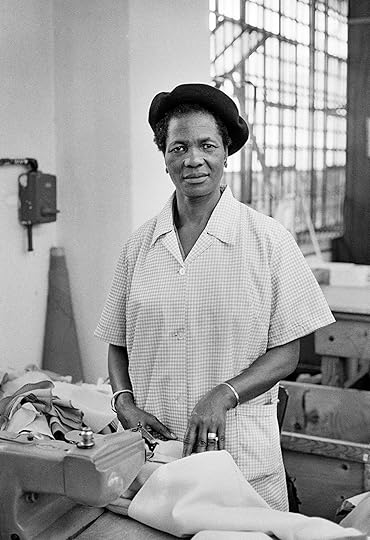 Sue Williamson, Caroline Motsoaledi I, 1984, from the series All Our Mothers
Sue Williamson, Caroline Motsoaledi I, 1984, from the series All Our Mothers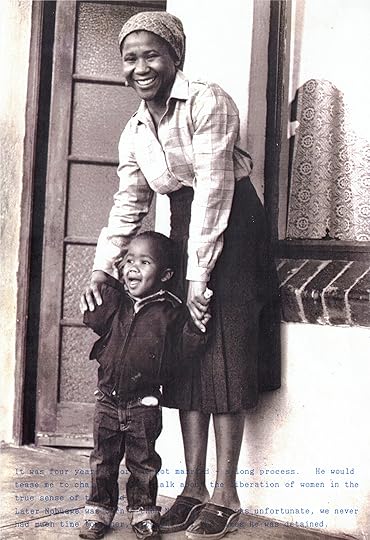 Sue Williamson, A Tale of Two Cradocks (detail), 1994
Sue Williamson, A Tale of Two Cradocks (detail), 1994 The exhibition Tell Me What You Remember, curated by Emma Lewis and currently on view at the Barnes Foundation in Philadelphia, thoughtfully addresses these questions as they surface in the work of South African artists Sue Williamson, who was born in 1941 and grew up under apartheid, and Lebohang Kganye, who was born in 1990, the year that then president F. W. de Klerk unbanned the African National Congress, setting in motion apartheid’s dismantling. Importantly, the landmark 1994 general elections created a generational divide between those who directly experienced the horrors of apartheid and those who have grown up in its aftermath (often referred to as “born frees”). Bringing together an artist from each side of this divide, the exhibition highlights how each thinks about memory in relation to both trauma and healing, as well as the subtle differences in their approaches.
Entering the gallery, visitors are greeted by images of women who lived through apartheid. Williamson’s contributions include multiracial portraits from her series All Our Mothers (1983–ongoing), which documents—with real emotional force—everyday people who fought against that system. The entryway to the exhibition also includes Kganye’s larger-than-life portraits of matrilineal ancestors from her series Mosebetsi wa Dirithi (2022), which the artist has beautifully rendered in carefully quilted swatches of fabric. This first moment of Tell Me What You Remember is the only one where Kganye’s and Williamson’s work is directly in dialogue; the rest of the exhibition is divided evenly between the two artists.
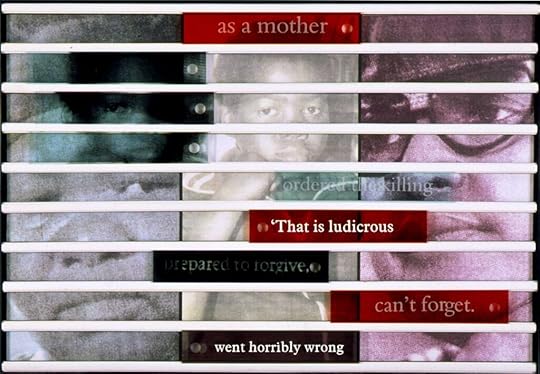 Sue Williamson, Truth Games: Joyce Seipei – as a mother – Winnie Madikizela-Mandela, 1998. Laminated color laser prints, wood, metal, plastic, Perspex
Sue Williamson, Truth Games: Joyce Seipei – as a mother – Winnie Madikizela-Mandela, 1998. Laminated color laser prints, wood, metal, plastic, Perspex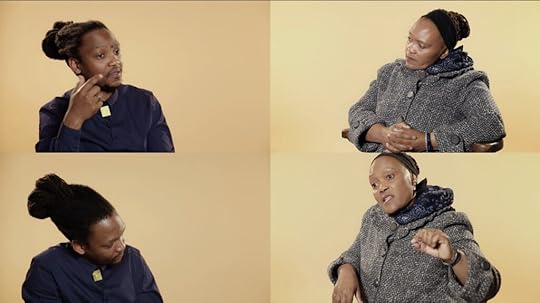 Sue Williamson and Siyah Ndawela Mgoduka, That particular morning, 2019, from the series No More Fairy Tales, 2016–19. Two-channel video, color, sound
Sue Williamson and Siyah Ndawela Mgoduka, That particular morning, 2019, from the series No More Fairy Tales, 2016–19. Two-channel video, color, soundCourtesy the artist and Goodman Gallery, Cape Town, Johannesburg, and London
In her multifaceted practice, Williamson explores the ways that apartheid laws affected individual lives and communities, and her side of the exhibition is organized into areas loosely categorized as “Testimony” and “Memory Work.” Her works in the latter section center on the effects of the Truth and Reconciliation Commission (TRC), and demonstrate the exhibition’s focus on the complexity of living memory. In the video installation That Particular Morning (2019), Doreen Mgoduka and her son Siyah Ndawela Mgoduka discuss the loss of Glen Mgoduka, a police officer whom apartheid police murdered in 1989 to cover up the role of white police colleagues in activist assassinations. More than a retelling of that trauma, the video stages a long overdue, and at times strained, conversation in which the two talk about how the death of Doreen’s husband and Siyah’s father has affected their relationship. Throughout much of the dialogue, Doreen sits back in her chair with her hands clasped or arms crossed as Siyah gestures broadly and occasionally wipes away tears. Each is captured by a different camera, although the two videos are projected onto one screen. This approach illustrates their different access to memory, and the difficulty of bringing the two perspectives into a seamless narrative.
Recreating images from family albums, Kganye returned to the sites of the photographs, often putting on the same outfit that her mother had worn and assuming her mother’s pose.
Reflecting an important theme of the exhibition, That Particular Morning seems to ask, what does all of this sharing of memory add up to? This question links many of Williamson’s works. For instance, in the series Truth Games (1998), she directs this question at the TRC hearings, in which victims of apartheid violence were brought together with perpetrators who confessed their crimes in the name of national “healing.” In each of these works, a press photograph from a well-publicized case is sandwiched between a photograph of an accuser on one side and a defendant on the other. Movable Perspex slats partially block the images, demonstrating how words can obscure the truth, or perhaps that full transparency remains forever out of reach. Similarly, Memorial to the Truth and Reconciliation Commission of South Africa (2016) resembles a tombstone upon which the alternating and repeating phrases “can’t remember” and “can’t forget” are printed onto glass. The difference between the inability to forget and the desire to not remember marks the power differential in the TRC process as well as the problems inherent in transforming personal memories into collective histories.
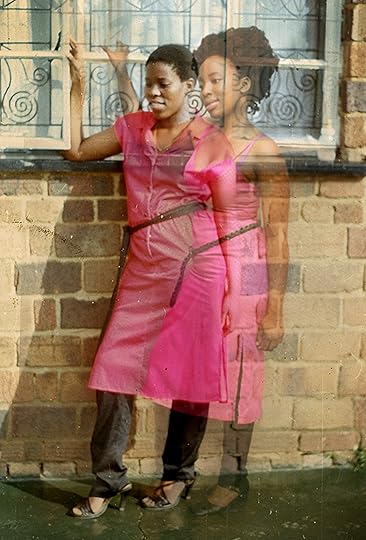 Lebohang Kganye, Setupung sa kwana hae II, from the series Ke Lefa Laka: Her-story, 2013
Lebohang Kganye, Setupung sa kwana hae II, from the series Ke Lefa Laka: Her-story, 2013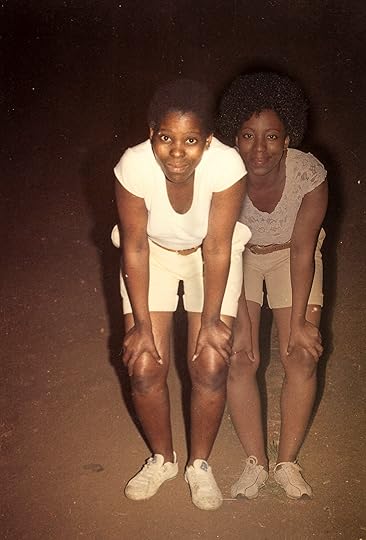 Lebohang Kganye, Ke tsamaya masiu II, from the series Ke Lefa Laka: Her-story, 2013
Lebohang Kganye, Ke tsamaya masiu II, from the series Ke Lefa Laka: Her-story, 2013In contrast, Kganye’s practice largely addresses apartheid indirectly, leading with explorations of her family’s archive. In the exhibition, works grouped together under the label “In Search for Memory” suggest the urgency and poignancy of such searching. For example, the sudden death of the artist’s mother in 2010 inspired a series called Ke Lefa Laka: Her-Story (2013). Recreating images from family albums, Kganye returned to the sites of the photographs, often putting on the same outfit that her mother had worn and assuming her mother’s pose. What began as separate images of reenactment transformed into photomontages of the two women, with the figure of Lebohang creating a ghostly double of the elder Kganye. The longing in these montages is especially apparent in Setshwantso le ngwanaka II (2013), where Kganye, wearing a red dress and a tender smile, mirrors her mother’s gesture of beckoning to a toddler who is the artist herself. These images bring to mind performance scholar Joseph Roach’s notion of surrogation, a process through which individuals—or collectives—perform the past to enact a sense of continuity. But as Roach points out, the process is always marred by the deficit or surplus created when a new person steps into an established role.
 Lebohang Kganye, Setshwantso le ngwanaka II, from the series Ke Lefa Laka: Her-story, 2013
Lebohang Kganye, Setshwantso le ngwanaka II, from the series Ke Lefa Laka: Her-story, 2013 Lebohang Kganye, Re intshitse mosebetsing II, from the series Ke Lefa Laka: Her-story, 2013
Lebohang Kganye, Re intshitse mosebetsing II, from the series Ke Lefa Laka: Her-story, 2013Rather than lament this lack of seamless continuity, Kganye makes works that revel in it, embracing the idea that family albums and, more broadly, family stories, are spaces of fantasy and creative possibility. In a short video titled Pied Piper’s Voyage (2014), she performs stories, gleaned from family members, about her grandfather’s journey from farmland in the Orange Free State to Johannesburg in search of work. As in the series Her-story, Kganye dons her grandfather’s clothes, but in this work, the doubling is even more theatrical: The artist moves among cardboard set pieces that are scaled-up photographs from the family archive. Posing alongside the black-and-white, two-dimensional set pieces, she enacts both the disjunct between the present and the past as well as the mutability of memory, demonstrating how an artist can rearrange elements of the past at will.
If Kganye’s work illustrates the power that artists have in restaging the past, the series In Search for Memory (2020) extends this idea into a speculative future. The works, photographs of miniature dioramas, are based on Ta O’Reva (2015), a science fiction novella by the Malawian writer Muthi Nhlema. In Nhlema’s apocalyptic setting, South Africa has collapsed in a sequence of events that began with a race riot and resulted in the spread of a deadly contagion. Kganye’s works picture some of the novella’s most powerful moments, as in the image He could hear the voices of his ancestors (2020), in which a little boy hides under a kitchen table as his father is being murdered by a white farmer, or The stranger stood before what to him was a monstrosity (2020), in which a reanimated Nelson Mandela surveys the nation’s ruin, an outcome that occurs in spite of a lifetime of sacrifice. If the images gesture to Afrofuturism, they are also resolutely dystopic.
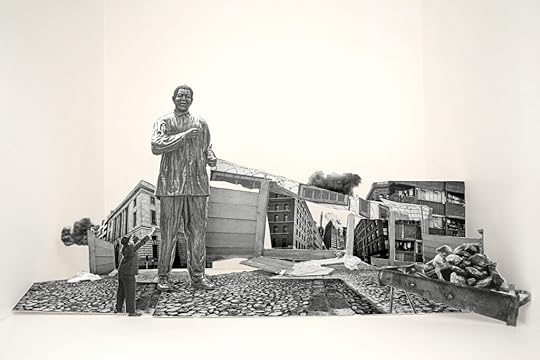 Lebohang Kganye, Untouched by the Ancient Caress of Time, 2022, from the series In Search for Memory, 2020–22. Fiberboard, cardboard, light
Lebohang Kganye, Untouched by the Ancient Caress of Time, 2022, from the series In Search for Memory, 2020–22. Fiberboard, cardboard, lightCourtesy the artist
In her essay on Williamson in the exhibition’s catalog, the writer Nkgopoleng Moloi describes the artist’s work as “the unfinished project of emancipation.” Tell Me What You Remember proposes that both Williamson and Kganye participate in this project, whether mining collective or personal archives or picturing possible futures. In either case, the artists powerfully engage memory as a material, pointing to its potential for transformation.
Sue Williamson & Lebohang Kganye: Tell Me What You Remember is on view at the Barnes Foundation, Philadelphia, through May 21, 2023.
May 2, 2023
How Tommy Kha’s Mischievous Portraits Challenge the Idea of Belonging
Tommy Kha told me about a moment, not too long ago, when he was photographing his mother and she asked him: Why is art always so sad?
She fled Vietnam in the eighties, raising Tommy and his sister in Memphis. When they were children, the history that had delivered their family to America was passed down in fragments and gestures. It was a story that was never told. Rather, it was carried through expressions or habits, with a tendency toward conversational dead ends, and in the chasm between shouting and silence. In her closet, Tommy’s mother had kept photographs from when she was younger, some from Vietnam but most taken in Ontario, her first home in North America, in the eighties. Washed-out snapshots of friends gathered around plates of food or birthday cakes, self-portraits on a pier, at the beach, with enormous stuffed animals, or perched in a tree. These pictures weren’t art, she was suggesting to Tommy, just moments from a past she never discussed.
 Tommy Kha, May (Acting), Mom’s Bedroom, Whitehaven, Memphis, 2013
Tommy Kha, May (Acting), Mom’s Bedroom, Whitehaven, Memphis, 2013  Tommy Kha, Constellations VIII, Prop Planet, Miami, 2017
Tommy Kha, Constellations VIII, Prop Planet, Miami, 2017 As Tommy pursued his own path as an artist, he and his mother settled into a routine. She would make him food, and then he would take pictures of her, usually inside her home or in her backyard, making these overfamiliar settings feel mysterious and alien. She frequently looks troubled in these images; maybe she is just annoyed. People need to smile more, she told him.
I don’t find Tommy’s work sad at all. A life-size cutout of Elvis Presley with Tommy’s face slapped over the iconic singer’s? This is hilarious, mischievous, surreal stuff. That’s not where he’s supposed to be, which is part of how his art seizes you. The compositions are gorgeous and meticulous, with Kha masterfully capturing these soothing, garish auras in the naturally occurring colors of our world. But there’s often something a bit off. A flourish—visual jokes, out-of-place expressions, a glimpse of a cutout of his own face—that marks his presence.
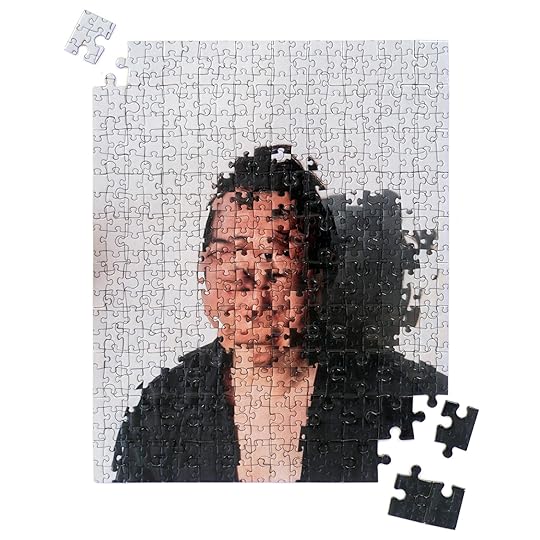 (Re) Assemblies, 2023 A limited-edition puzzle of one of Tommy Kha’s idiosyncratic self-portraits from the monograph Tommy Kha: Half, Full, Quarter (2023).
(Re) Assemblies, 2023 A limited-edition puzzle of one of Tommy Kha’s idiosyncratic self-portraits from the monograph Tommy Kha: Half, Full, Quarter (2023). $150.00Add to cart
[image error] [image error]
In stock
(Re) Assemblies, 2023 $ 150.00 –1+$150.00Add to cart
View cart Description Aperture is pleased to release this special limited-edition puzzle by the artist Tommy Kha on the occasion of the publication Tommy Kha: Half, Full, Quarter (2023). In this first monograph, the result of the Next Step Award, a collaboration between Aperture and Baxter St at the Camera Club of New York, in partnership with 7|G Foundation, the artist explores the personal psycho-geography of his hometown and weaves together self-portraits and classically bucolic landscapes punctuated by the traces of East Asian stories embedded in the topography of the American South. In assembling a visual record of the struggle to find his own voice and to create a fragmented portrait of his family, Kha challenges the cultural amnesia around Asian lives and experiences in recent American histories. (Re) Assemblies, 2023 brings together a limited-edition puzzle of one of Kha’s idiosyncratic self-portraits. DetailsLimited-Edition Puzzle
Size: 8 x 10 inches
Edition of 150
Signed and numbered by the artist
Tommy Kha (b. 1988, Memphis, TN) lives and works between Brooklyn and Memphis. He received his MFA from Yale University in 2013, and is the recipient of the 2021 Aperture–Baxter St Next Step Award.
When Tommy began taking photographs, he was inspired by the work of Nan Goldin to document his friends, many of them performers and musicians, as they made their racket around town. To better pull focus for his self portraits, he toted around an Elvis cutout. But over time, inspired in part by Claude Cahun, Reka Reisinger, and Tseng Kwong Chi, he began incorporating the cutouts themselves, producing a different kind of self-representation. On one hand, these self-portraits dramatize his sense of dislocation—of not belonging, maybe even invading, or judging, these scenes of pure Americana. They suggest an insolubility, the impossibility of assimilating, whether into a nation or an everyday background. He experimented with printing his face on pillows or puzzles so that he was, quite literally, fragmented. But all of this felt playful too. His family and friends cradled his cutout, played dress-up with a reproduction of his face, as if poking fun at its overly serious, some might say inscrutable, expression.
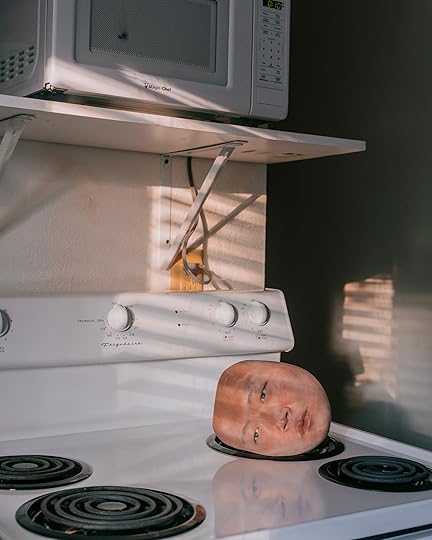 Tommy Kha, Headtown (XII), Midtown, Memphis, 2021
Tommy Kha, Headtown (XII), Midtown, Memphis, 2021
 May (Pattern Drafting), London, Ontario, ca. 1984
May (Pattern Drafting), London, Ontario, ca. 1984
Most of the photos in this book were taken by Tommy. Interspersed are faded snap-shots from a photo album his mother passed onto him and his sister a few years ago with little explanation or context. The pictures are full of friends and acquaintances from her early years in Ontario, most of whom the children do not know. Some of the photos are reproduced here in full; others have been cut to lift figures from backgrounds and are arranged into collages, leaving only jagged, island-like clusters of new immigrants against a blank expanse.
Advertisement
googletag.cmd.push(function () {
googletag.display('div-gpt-ad-1343857479665-0');
});
The children of immigrants learn of the world first through the oft-limited horizons of those around us. We don’t see ourselves in the culture, so we learn how to breach America by studying our families, our parents, and nearby elders. Photography was the only form of art they participated in, only it wasn’t art, it was just something to do. It was a ritual, a place to put their memories, fleeting visions of the new world to mail back to the old one, if anyone was still there. There were minor details of self-presentation, like a cherished piece of clothing or a carefree smile, perhaps the only gestures of self-fashioning that felt comfortable in those days. The fact that Tommy’s mother had kept this album all these years communicates enough.
 Tommy Kha, Stations (Viet Hoa Market), Cleveland Street, Memphis, 2021
Tommy Kha, Stations (Viet Hoa Market), Cleveland Street, Memphis, 2021And you realize: this isn’t just Tommy’s book, and the photos from the eighties aren’t just there to provide context about his world. These snapshots sit effortlessly alongside his austere pictures of Memphis and his carefully staged family portraits. Together, they offer us a sense of collaborative possibility, a wondrous back-and-forth between present and future, a collaboration that goes unremarked upon, since there are certain aspects of the past that we never talk about. Instead, the images in this book speak to one another in glances, smiles, echoes. What we inherit isn’t just language but the angle you hold your head when you listen.
 Tommy Kha, Mine IX, Den(tist Room), Whitehaven, Memphis, 2017
Tommy Kha, Mine IX, Den(tist Room), Whitehaven, Memphis, 2017 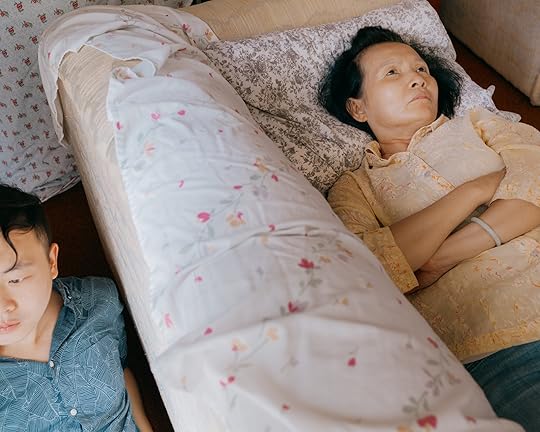 Tommy Kha, May (with Her Half Self-Portrait), Whitehaven, Memphis, 2017
Tommy Kha, May (with Her Half Self-Portrait), Whitehaven, Memphis, 2017 There are photos of Tommy’s mother in the corner of her father’s home dental office, where he practiced in private for family and friends after not being able to establish his license in the US. A cutout of Tommy’s face is nestled in the chair. He doesn’t belong there. Then again, the room itself indexes an entire history of not belonging. Elsewhere, mother and son lie next to one another in a living room, gazing in different directions. Her face is weary, perhaps because that’s what she thinks she’s supposed to do with her face. She’s playacting. But sometimes, she looks back at the camera, at Tommy, and she understands that they are there at the same time, sharing a moment, even if neither of them can put to words what that is.
These pictures aren’t sad; they’re hopeful. They luxuriate in the ongoingness of family and history. Nothing is resolved. But what draws us forward are moments of reckoning, as generations take turns telling a shared story. A fragment will never join with the whole. It is a new whole.
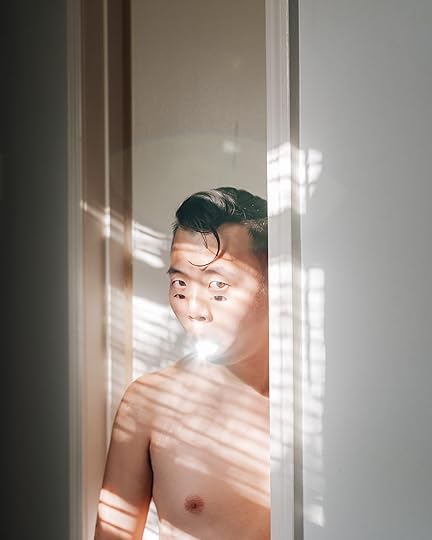 Tommy Kha, Exchange Place VI, Midtown, Memphis, 2019
Tommy Kha, Exchange Place VI, Midtown, Memphis, 2019  Tommy Kha, May (or Half a Self-Portrait), Whitehaven, Memphis, 2017
Tommy Kha, May (or Half a Self-Portrait), Whitehaven, Memphis, 2017 This essay originally appeared in Tommy Kha: Half, Full, Quarter (Aperture, 2023).
April 28, 2023
A Midcentury Portrait of Black Culture in Pittsburgh
Sometime in the middle of the last century, Charles “Teenie” Harris became known for often taking only one picture of his subjects, and was aptly nicknamed “One Shot” by the former mayor of Pittsburgh David L. Lawrence. “He was fast,” Charlene Foggie-Barnett, the Teenie Harris community archivist at the Carnegie Museum of Art, told me over Zoom in late October 2022. “He’d run in and say, ‘Get together, everybody, I’m only gonna take one shot.’” With a determined energy, Harris took “one shot” many, many times in his long career, capturing the ordinary beauty of Black life in the city.
Professionally, Harris started out at the Washington, DC–based Flash Weekly Newspicture Magazine, but he had been exposed to photography since he was a small child. For more than forty years, Harris was the leading photographer for the Pittsburgh Courier, one of the country’s largest Black newspapers. At the Courier, he worked on assignments ranging from the civil rights movement (protests, rallies, and marches) to local events such as birthdays, community meetings, cultural programs, and sports activities. Intersecting with the lives of innumerable Pittsburgh residents as a street photographer, studio photographer, and photojournalist, he made note of what he saw as a member of Pittsburgh’s Black communities, touching on themes of sexuality, religion, intimacy, memory, slavery, and more. He lived for ninety years, nearly the twentieth century in its entirety. His work poses the question, How can photography be conceived as a history of experience?
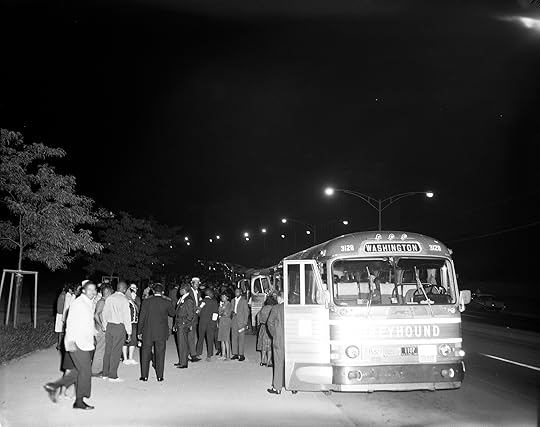 Charles “Teenie” Harris, Greyhound buses going to the March for Freedom and Jobs in Washington, DC, 1963
Charles “Teenie” Harris, Greyhound buses going to the March for Freedom and Jobs in Washington, DC, 1963  Charles “Teenie” Harris, Protesters, Pittsburgh, ca. 1963
Charles “Teenie” Harris, Protesters, Pittsburgh, ca. 1963 Harris’s presence in Pittsburgh’s historically Black Hill District, Speed Graphic camera in hand, was ubiquitous. As exclaimed in He’s a Black Man!, an early 1970s Sears Public Affairs radio series, “There may very well be a Black person in Pittsburgh who hasn’t had his photo snapped by ‘Teenie’ Harris, but that would more than likely be a Black person in Pittsburgh who hasn’t had his picture taken at all.”
Through Harris’s eyes, the pressures of historic events including the Great Depression, the Great Migration, Black freedom struggles, civil rights campaigns, World War II, and Jim Crow were given rich visual references. Harris captured the contours of political life: a Black elder named Mary Reid holding a note defaced with swastikas, reading “Kill All Blacks” and “Stop Niger [sic] Take Over”; a billboard advertising the 1968 Poor People’s Campaign demanding low-income housing and a moratorium against redevelopment in the Hill District; and a 1970 broadside of the Black Panther manifesto. He also photographed cultural icons when they passed through a deeply segregated and heavily policed Pittsburgh, a city he rarely left: well-known musicians (Louis Armstrong, Dizzy Gillespie, Duke Ellington), politicians (John F. Kennedy, Eleanor Roosevelt, Richard Nixon), civil rights leaders and organizers (Dr. Martin Luther King Jr., Stokely Carmichael), dancers (Josephine Baker), singers (Lena Horne, Sarah Vaughan, Eartha Kitt), and athletes (Jackie Robinson, Muhammad Ali, Willie Mays). As the art historian Nicole Fleetwood writes in her 2011 book Troubling Vision: Performance, Visuality, and Blackness, “Harris’s lens provides an alternative visual index of black lived experience of the twentieth century, one that does not rely on the familiar device of photographic iconicity.”

Charles “Teenie” Harris, Possibly the Loendi Club, Pittsburgh, ca. 1930–45
var container = ''; jQuery('#fl-main-content').find('.fl-row').each(function () { if (jQuery(this).find('.gutenberg-full-width-image-container').length) { container = jQuery(this); } }); if (container.length) { var fullWidthImageContainer = jQuery('.gutenberg-full-width-image-container'); var fullWidthImage = jQuery('.gutenberg-full-width-image img'); var watchFullWidthImage = _.throttle(function() { var containerWidth = Math.abs(jQuery(container).css('width').replace(/\D/g, '')); var containerPaddingLeft = Math.abs(jQuery(container).css('padding-left').replace(/\D/g, '')); var bodyWidth = Math.abs(jQuery('body').css('width').replace(/\D/g, '')); var marginLeft = ((bodyWidth - containerWidth) / 2) + containerPaddingLeft; jQuery(fullWidthImageContainer).css('position', 'relative'); jQuery(fullWidthImageContainer).css('marginLeft', -marginLeft + 'px'); jQuery(fullWidthImageContainer).css('width', bodyWidth + 'px'); jQuery(fullWidthImage).css('width', bodyWidth + 'px'); }, 100); jQuery(window).on('load resize', function() { watchFullWidthImage(); }); }In 1937, Harris opened his own studio. In addition, he regularly freelanced for advertising agencies and insurance companies in order to make ends meet given the scant resources on offer from the Black press. Still, roaming around Black Pittsburgh, he made photographs that were just for him, for the sake of his craft, which often exceeded the limits of documentary photography and reportage. Harris’s practice combined the ordinary, uniquely vibrant character of Black life, including such shiny events as family portraits, weddings, baptisms, and funerals, with the more quotidian subjects of work and birth. He took pictures inside hotels, nightclubs, homes, restaurants, boxing rings, and kitchens; on tree-lined, brick-paved, stoop-filled streets; at railroad yards, police stations, demolitions, groundbreakings, and picnics. He never stopped taking pictures.
The Carnegie Museum of Art’s permanent Teenie Harris collection contains more than seventy thousand negatives from Harris’s working career, spanning from the 1930s to the 1980s. Tens of thousands still need to be digitized; among the selection here are several previously unpublished images, part of a major scanning project underway at the museum. Some images from Harris’s formidable photographic archive are online and searchable. They have woozily long titles describing what they depict (partly because the recording of this information is ongoing). Over the past twenty years, since the institution purchased the Harris archive in 2001 from the artist’s estate (a wish of Harris’s before his death), the Carnegie has searched for more details and identifications. The catalog listings, which continue to evolve as new information becomes available, come from oral histories done with people who appear in Harris’s photographs or from research via the Pittsburgh Courier or Flash Weekly Newspicture Magazine.
 Charles “Teenie” Harris, Untitled, Pittsburgh, ca. 1962
Charles “Teenie” Harris, Untitled, Pittsburgh, ca. 1962 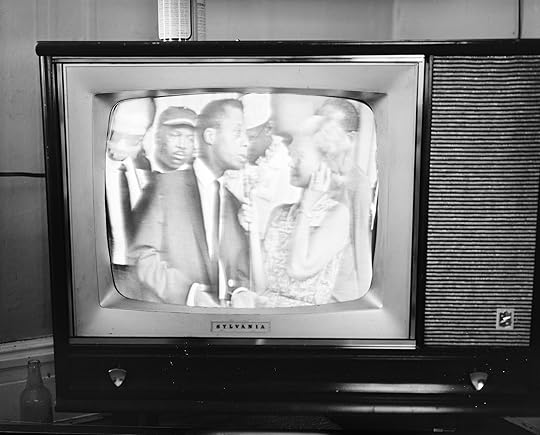 Charles “Teenie” Harris, A television playing coverage of James Baldwin at the March for Freedom and Jobs in Washington, DC, 1963
Charles “Teenie” Harris, A television playing coverage of James Baldwin at the March for Freedom and Jobs in Washington, DC, 1963 Instrumental to the contemporary and historical Harris moment, as well as to the Carnegie, is Foggie-Barnett, who knew Harris and was photographed by him as a child in the Hill District. She describes Harris as a friend of her parents, Bishop and Mrs. Charles H. Foggie, who were civil rights leaders. “Teenie was just an everyday occurrence,” she recalls, with pride. “It was not uncommon, for a lot of people, to have Teenie pop up at any time.”
In 2006, when Foggie-Barnett read in the newspaper that the Carnegie Museum of Art was looking for children photographed by Harris, she was the only person who showed up at the museum. “Part of the concern, of course, was what is the Carnegie doing with these images?” she says. The recording of this history is urgent, but the critique of big institutions, which often excluded and exploited the Black community, is just as pressing. Many of Harris’s acquaintances are nearing the end of their lives, but they still express an unsurprising distrust of institutional archives or a fear that they may not say the “right thing.”
 Aperture Magazine Subscription Get a full year of Aperture—and save 25% off the cover price. Your subscription will begin with the winter 2022 issue, “Reference”.
[image error]
[image error]
Aperture Magazine Subscription Get a full year of Aperture—and save 25% off the cover price. Your subscription will begin with the winter 2022 issue, “Reference”.
[image error]
[image error] 
In stock
Aperture Magazine Subscription $ 0.00 –1+ View cart DescriptionSubscribe now and get the collectible print edition and the digital edition four times a year, plus unlimited access to Aperture’s online archive.
Foggie-Barnett ended up creating an oral history with the museum. “The archive had come almost exclusively unidentified to the Carnegie,” she says. “And so, the first-person interviews and people talking about their lived experiences as seen through Teenie’s lens was the way they were building the information of the archive. I got so excited by and so appreciative of how the staff treated the information. They were very delicate in how they asked questions and were very clear and sincere about what their intentions were,” she explains. “I started bringing some people with me that they couldn’t get to come down. And a lot of those were elderly people, like my original childhood hairdresser [Gloria Golden Grate], who had her own shop but was also one of the first Black models in Pittsburgh.”
Foggie-Barnett began volunteering at the museum in 2006 and was hired in 2010 as the community archivist. She is now a well-respected steward of the Harris archive, involved in preserving, curating, and broadening the collection’s scope and community relevance. Along with the archivist Dominique Luster, she co-organized In Sharp Focus: Charles “Teenie” Harris, a permanent exhibition in the Carnegie’s Scaife Galleries that opened in January 2020. As a researcher studying the Harris archive, Foggie-Barnett conducts oral histories and coordinates outreach by bringing exhibition prints to nursing homes, delivering lectures in schools and on campuses, and giving tours of the exhibition.
Looking at the subjects in Harris’s pictures, we see people who find comfort and trust in a world where comfort and trust are never guaranteed.
At its core, Harris’s picture-making practice was aimed at a Pittsburgh in transformation, shifting from a steel-producing hub of industrialism to a city best described as postindustrial. As the city changed, many tensions around segregation and desegregation, for example, unraveled at the Highland Park pool. In the 1940s and 1950s, civil rights organizers in Pittsburgh staged demonstrations involving interracial swimming. As the historian Joe William Trotter Jr. notes in his essay “Harris, History, and the Hill,” published in the 2011 catalog Teenie Harris, Photographer: Image, Memory, History, white people harassed the swimmers. Harris photographed many outdoor and indoor pools: some give off a sense of leisure (glamorous poses, a hand on the hip), others focus on sports (boys lined up at the edge of a pool for a swim meet), but all are overburdened by the historical fact that municipal swimming pools were crucial sites of racial violence during segregation. The corresponding fear of Black people “contaminating” whites loomed large.
Harris wanted you to see, but he also wanted you to listen to the stories he was presenting in his art. “He is leaving clues, he is revealing story lines and truths,” says Foggie-Barnett. “He’s making a statement.” Harris trains the eye to notice more idiosyncratic acts, that mental montage of stills ever blowing in our head, at the edges of memory.
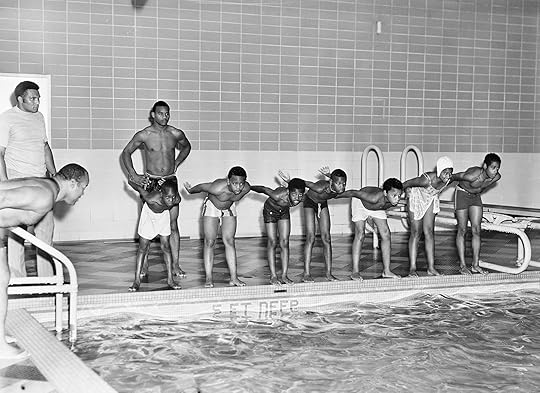 Charles “Teenie” Harris, Swimmers, Pittsburgh, ca. 1971
Charles “Teenie” Harris, Swimmers, Pittsburgh, ca. 1971 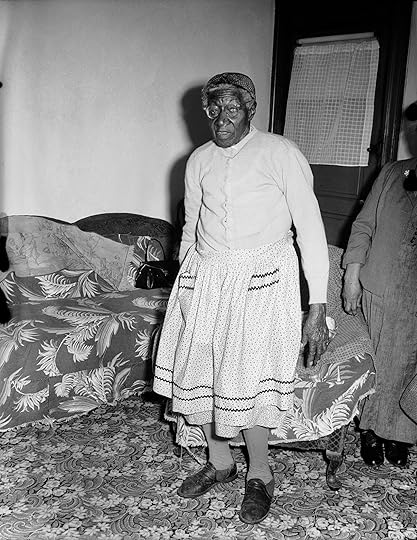 Charles “Teenie” Harris, Sabre “Mother” Washington, a formerly enslaved person, on her 109th birthday, in her home on Conemaugh Street, Pittsburgh, 1954
Charles “Teenie” Harris, Sabre “Mother” Washington, a formerly enslaved person, on her 109th birthday, in her home on Conemaugh Street, Pittsburgh, 1954 A single Harris photograph can take the form of a transgenerational account of the present. In one image, from December 1954, Sabre “Mother” Washington, a formerly enslaved woman, stands in her Conemaugh Street home on the occasion of her 109th birthday. The image would be remarkable on its own, but Washington, seemingly having just stood up from her floral-patterned chair for the picture, and with her shadow imprinting the living room wall behind her, gives the impression that she
is hovering, evoking the hauntings of the slave trade.
In other photographs, in which people aren’t always as readily identifiable, some looking directly at the camera and others seemingly posed, subtleties break through the frame: a Sylvania television playing footage from the 1963 March on Washington, forcing the viewer to take note of the technologies of representation. Harris’s oeuvre chronicles historic events but also what the art historian Cheryl Finley calls, in Teenie Harris, Photographer, “glimpses of everyday life and the people who gave it vitality, dignity, and purpose.”
Advertisement
googletag.cmd.push(function () {
googletag.display('div-gpt-ad-1343857479665-0');
});
Harris often provided visual language to interstices only he could see. Swirling night scenes—the subtle shift in brightness as lights twinkle over a foggy steel mill; sparsely populated urban landscapes; the subdued, anxious excitement of people standing around Greyhound buses for a march—reveal an aesthetic perspective that is an essential element of his work, cementing Harris’s position as not only a photojournalist and studio photographer but an artist. Harris’s rendering of Black skin and epidermal intensity was yet another sign of his creative virtuosity. Foggie-Barnett informs me that Harris used dodging and burning techniques in the darkroom so that Black skin would develop in rich shades.
As The Black Press: Soldiers without Swords, a 1999 documentary film by Stanley Nelson, illuminates, Black print culture played a determining institutional role in fighting white supremacy, especially during the twentieth century. Photographs are not only visual archives of the past but the axis on which people represent themselves, or see themselves represented. In Teenie Harris, Photographer, the historian Laurence Glasco describes Harris as a people person who often used comedy as a way to deflect attention from his four-by-five-inch handheld camera. Looking at the subjects in Harris’s pictures, we see people who find comfort and trust in a world where comfort and trust are never guaranteed, especially considering the ethnographic exploitation at the time by many American photographers slumming it for the shot.
 Charles “Teenie” Harris, Untitled, Pittsburgh, ca. 1962
Charles “Teenie” Harris, Untitled, Pittsburgh, ca. 1962All photographs courtesy Carnegie Museum of Art, Heinz Family Fund
Yet another important instance of Harris’s representation of the ill-represented: “He has an array of photos of the LGBTQ+ community that most people didn’t know existed,” Foggie-Barnett tells me. In 2018, Black Artists’ Networks in Dialogue (BAND) Gallery, in Toronto, exhibited Harris’s work in a show called Cutting a Figure: Black Style through the Lens of Charles “Teenie” Harris, which featured midcentury scenes of queer and transgender aesthetic culture, such as the drag performers “Gilda” and “Junie” Turner in feathered costumes. “These images reveal the complete trust his subjects had in Harris,” reads the online blurb. “Any spectacle related to outlandish dress is overshadowed by Harris’s intimate and familial treatment of his subjects.”
Harris’s work was, and is, part of the fabric of the continued making of a heterogeneous Black narrative in Pittsburgh and beyond. One finds oneself changed by his visually quiet sociability. “He is the keeper of our history,” Foggie-Barnett says. She encourages those who are young to explore Harris’s archive and ask questions about what it means for them and their future. What remains will be up to them.
This article originally appeared in Aperture, issue 250, “We Make Pictures in Order to Live.”
The Photographers Who Envisioned Queer History and Resistance
On the evening of February 9, 2023, in a standing-room-only presentation for a raucous audience at the LGBT Center in Manhattan, Joan E. Biren (JEB) did something for the first and last time in thirty-nine years: a live performance of her Lesbian Images in Photography: 1850–the present (1979–1985). The Dyke Show, as it is more popularly called, is a slideshow comprised of hundreds of portraits, documentary images, and erotic photography by artists ranging from Alice Austen to Tee Corinne. Images on which to build, 1970s–1990s, an exhibition curated by Ariel Goldberg and currently on view at the Leslie-Lohman Museum in New York includes a digitized version of The Dyke Show and seeks to carry on the ambition, enthusiasm, and intergenerational through lines of JEB’s work.
The exhibition is overwhelming—in the best way—in its six distinct but inextricably connected sections. These include photography by Lola Flash alongside ART+ Positive (a small artist collective dedicated to fighting AIDS phobia); documentary images from the vast archive of artist and educator Diana Solís; a selection of images of African American lesbians from the Lesbian Herstory Archives; snapshots, correspondence, and newsletters that showcase sundry trans networks; and Electric Blanket, a slideshow installation of images related to HIV/AIDS, from portraits of dead loved ones to photo essays to protest slogans and statistics.
Images on which to build, which was originally presented at the 2022 FotoFocus Biennial in Cincinnati, showcases artists and collectives that participated in, and ultimately built, robust trans and queer image cultures with lasting influence. The title card for each section looks and feels like a vintage activist button, reminding us that these projects were never only “art for art’s sake.” And neither is this exhibition. Indeed, in form and content, Goldberg’s mission is in keeping with their predecessors’: the work is offered in the spirit of education, inspiration, and interconnection.
I recently spoke with Goldberg, who exudes passion and purpose. “When I started to approach people, my tenor was one of humility,” they told me. “I never thought I was discovering anyone; I was simply bridging the gaps of historical erasure for all those artists and culture workers who have been ignored by incomplete photographic histories.” The result of their gap-filling is a sort of interstellar vastness as moving as it is galvanizing.
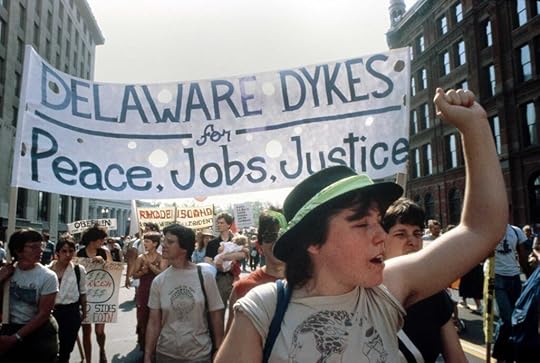 JEB (Joan E. Biren), Delaware Dykes for Peace, Jobs, & Justice, ca. 1979, from The Dyke Show
JEB (Joan E. Biren), Delaware Dykes for Peace, Jobs, & Justice, ca. 1979, from The Dyke ShowCourtesy the artist
Kerry Manders: What was the impetus for this exhibition?
Ariel Goldberg: The fire—fueled by anger and disbelief—really started in 2015 when I was finishing my book The Estrangement Principle about the label “queer art” and asking: what’s my queer lineage in photography?
I knew it had to be deeper than Robert Mapplethorpe and his Hasselblad. I was starting with how modes of representation are contested in queer history, reading Isaac Julien and Kobena Mercer, thinking about Lyle Ashton Harris and others who were pushing back against an elite white gay male history. I wanted to learn about everything that doesn’t assimilate into the commercial fine art world.
The fire was also ignited when I read Sophie Hackett’s article on The Dyke Show by JEB [Joan E. Biren] in the “Queer” 2015 issue of Aperture. That gave me a concrete example of what we could find if only we looked.
Manders: Your mission was to recover and re-present those artists.
Goldberg: I started this research in part because I wanted to experience the slideshows that I was told I can’t see anymore because they were live events. You can reconstruct historical multimedia projects like The Dyke Show if you are devoted to the long process and move at the speed of trust with the people who made them.
 Diana Solís, Flexing our Muscles: Gathering of Friends, Greenview Street, Lakeview, Chicago, IL, 1981
Diana Solís, Flexing our Muscles: Gathering of Friends, Greenview Street, Lakeview, Chicago, IL, 1981Courtesy the artist
Manders: Can you give us a snapshot of this moment in time on which your exhibition focuses? How do you differentiate it from what came before?
Goldberg: The late ’70s through the late ’90s is a very important moment in trans and queer history because that was when people were coming out and taking that risk in perpetuity: they were not going back in the closet. Right before this, visual records of trans and queer life most often belonged to the state—like arrest records—or were tabloid-y, sensationalized news stories of gender “discovery.” There were criminalizing narratives, or even outright destruction—families destroying personal archives of their queer relatives and even people destroying their own archives for fear of discovery. Even Diane Arbus’s photograph of Stormé DeLarverie was too controversial for Harper’s Bazaar to publish in 1961.
Manders: Where and how did you find these artists? Can you pull back the curtains on the “making of” this exhibition?
Goldberg: It’s multifaceted—there’s no template. My methods depend on the person I’m researching. I do the maximum amount of research I can before engaging in dialogue with an artist or archivist.
The artist Nicole Marroquin, whom I met at a Magnum Foundation event, introduced me to Diana Solís. Ever since, I leave each conversation with Diana—and the many artists and scholars working with them—with more names of people and events to look up, more books and articles to read. I remember the first time I visited Chicago, Nicole said I must read this book Chicanas Movidas, and has since shared articles in English on the Encuentro Feminista Latinoamericana y del Caribe. I still have a lot of learning to do about Chicago social movement history, Chicana, Mexicana histories of the Midwest, and Latin American feminist history if I’m to even fathom Solís’s work.
I apply to get travel funds that are available through archives to go to personal papers. I basically riffle through boxes and boxes of stuff. I try to zoom out and understand who was supporting the photographers’ work. Especially when I was just beginning in JEB’s papers, I started to see repeated names like Tee Corinne and Morgan Gwenwald, and patterns of relationships.
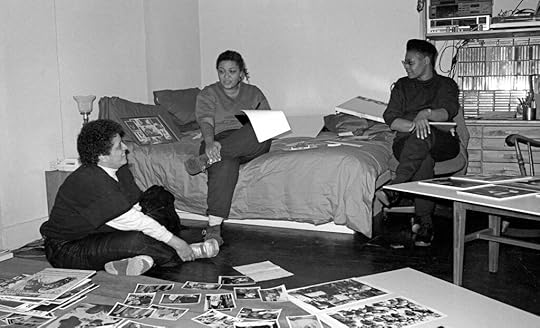 Morgan Gwenwald, Working on the “Keepin’ On” exhibition, 1991. Left to right: Paula Grant, Jewelle Gomez, Georgia Brooks
Morgan Gwenwald, Working on the “Keepin’ On” exhibition, 1991. Left to right: Paula Grant, Jewelle Gomez, Georgia BrooksCourtesy the Artist
Manders: That’s lovely. You built this exhibition via a network of relationships you found in the archives, which you then translate in your curatorial choices. Interconnection and overlap are key elements of the show.
Goldberg: Yes! When I was working with Diana Solís on the edit of their photographs, I remember getting excited when I saw, in the background of a photograph taken at Mujeres Latinas en Acción, matted photographs on the wall behind the table where a group of women were having a meeting. That group included Diana’s mother, their friend Diane Ávila, and her mother, too. When I asked whose photos were on the wall, Solís responded it was their own work and likely their students’ work from the photography class they were teaching at Mujeres in the late 1970s.
The late ’70s through the late ’90s is a very important moment in trans and queer history because that was when people were coming out and taking that risk in perpetuity: they were not going back in the closet.
This scene is what I am hoping to achieve with the exhibition broadly: creating a space for people to gather and make connections about photography and art’s critical role in organizing across generations. At the openings in Cincinnati and New York, artists and archivists from different cities were getting to meet and appreciate each other through the varied contexts of each other’s work.
The goal was not only about finding material, but also about meeting and connecting people who were not already acquainted. Personally, the ongoing power of this work is the relationships and mentorships I’ve been lucky to cultivate through this process.
Manders: That makes me think of one of the various resonances of the exhibition title—images on which to build relationships. This exhibition seems to be as much about community as it is about art.
Goldberg: Aldo Hernández, one of the organizers of ART+ Positive, reminded me that their work was about communities and collectivities, not about individuals and careers. It was about organizing and doing as much as you could with what little you had. He once said to me, “Oh, we were foam core queens!” And I thought, That kind of sums it up, getting work out there in the ways that were most affordable and easiest to schlep around.
One of my design challenges was to honor the Lesbian Herstory Archives foam core exhibition boards alongside framed archival ink-jet prints. I wanted to show that these practical materials traveled. They’ve been to student centers and volunteer-run archives. That ding on the corner of the foam core board—that wear and tear—is filled with the love of the previous audiences receiving the work.
Related Items
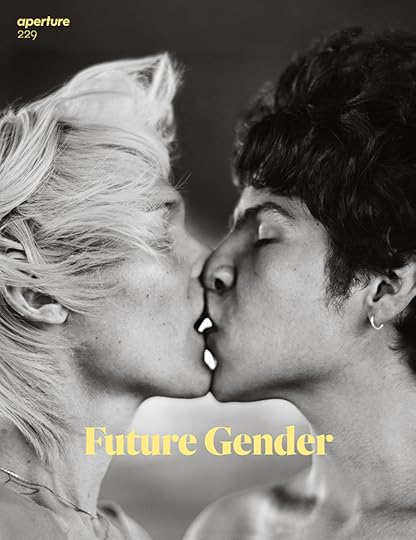
Aperture 229
Shop Now[image error]
Aperture Magazine Subscription
Shop Now[image error]Manders: What have you learned in the process of curating this exhibition? What are some crucial takeaways?
Goldberg: The first, most beautiful lesson is that organizing as image makers takes so many different forms.
On the one hand, I’m looking back. I’m doing all this inspiring time travel and celebrating the ways in which our predecessors came together and solved problems. AIDS activists learned the science for treatment—and tirelessly fought for the funding.
On the other hand, I’m thinking in the present tense. We are in a horrifying conservative backlash right now that could really be immobilizing. How can I work and pay my rent, but also bring my skills to all the amazing grassroots organizing happening right now, from prison abolition, defunding the police, affordable housing, canceling student debt, Palestine—all of which are interconnected struggles—to the current onslaught of anti-trans legislation? How can I be of service?
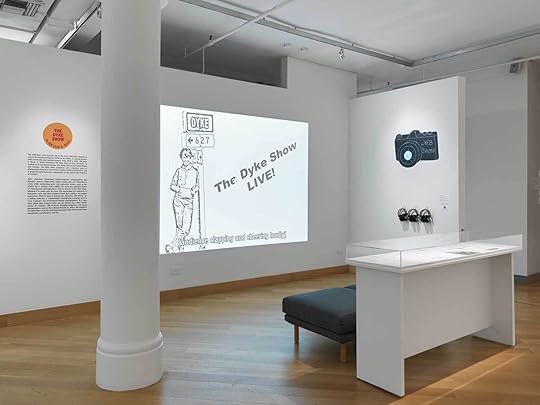 Installation views of Images on which to build, 1970s–1990s, Leslie-Lohman Museum of Art, New York, 2023
Installation views of Images on which to build, 1970s–1990s, Leslie-Lohman Museum of Art, New York, 2023Photographs by Object Studies

Manders: Now you’re reminding me of the rest of the quotation from which you borrowed your title. In an early review of JEB’s Dyke Show, Carol Seajay claimed these were “Images on which to build a future.” This exhibition, like the image cultures it showcases, is as interested in doing as it is in being.
Goldberg: A lot of trans and queer image making was all about self-determination beyond representation.
For example, Loren Rex Cameron, who was a part of the FTM support group in San Francisco, took pictures of people at different stages of transitioning, and those pictures played a part in educating people about hormones and surgeries. His photographs give us a way to understand how people were using photography to share non-pathologizing transgender medicine and build stronger movements.
The “doing” also speaks to how I wanted to share materials about the joy of gathering! I don’t want to lose that aspect of it. I’ve learned that didactic projects are also about community building and fun. Look at ART+Positive’s Queer Beauty series that Lola Flash photographed: people were spelling the phrase with their naked bodies! This isn’t dry material! Enjoyment in education is part of the work.
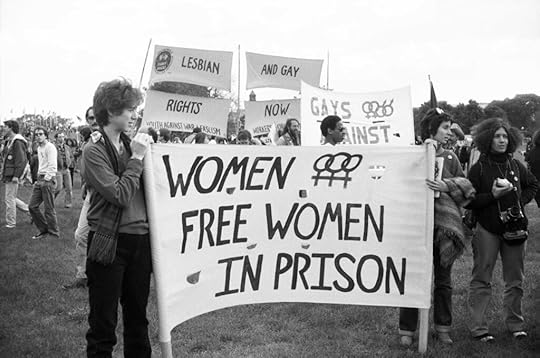 Diana Solís, Women Free Women in Prison, March on Washington, 1979
Diana Solís, Women Free Women in Prison, March on Washington, 1979Courtesy the Artist
Manders: I’m struck by the breadth of this exhibition—the fullness of your curatorial essay and exhibition text and even acknowledgments. We’ve joked about our shared “maximalist tendencies.” It’s not an inability to edit but, instead, a commitment to community, pedagogy, and material history.
Goldberg: Captions are a great metaphor for my work. I felt inspired to begin research for this exhibition while I was working on my photo history book Just Captions: Ethics of Trans and Queer Image Cultures. The caption is my rallying call to learn the names of people who appear in images. To then ask questions about how they were showing up for movements. Beyond the literal, I think of captions as an expandable poetic space, as curiosity for multiple narratives.
The show demonstrates how people were supporting and making culture. The columns in the exhibition space are wheat pasted with a single flyer or newsletter page from each of the six sections of the show. The Electric Blanket slideshow call for photographs, Rupert Raj’s Metamorphosis, which was the inspiration for Lou Sullivan’s FTM Newsletter. I want to show how these projects addressed their audiences. Wherever possible, I included a review of the slideshow or exhibit, in part to prove the work was recognized in feminist, trans, and queer communities.
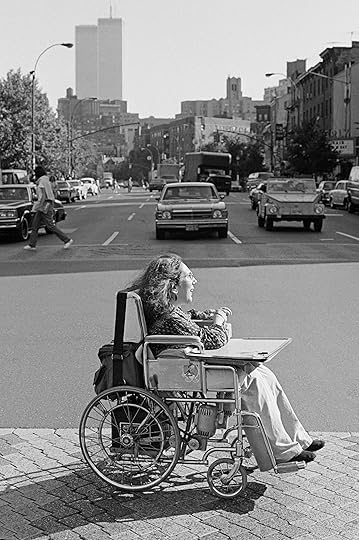 JEB (Joan E. Biren), Connie Panzarino, New York City, 1979, from The Dyke Show
JEB (Joan E. Biren), Connie Panzarino, New York City, 1979, from The Dyke ShowCourtesy the artist
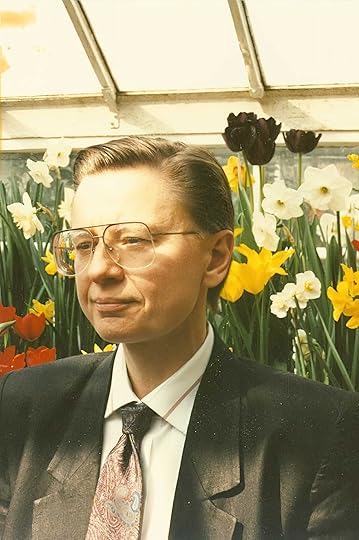 Portrait of Bet Power (now Ben Power Alwin), April 1990
Portrait of Bet Power (now Ben Power Alwin), April 1990Courtesy the Sexual Minorities Archives, Miscellaneous Photography Collection and Digital Transgender Archives
Manders: That makes me curious about the echoes and reverberations of these image cultures. How do we see their influence in the years after? And today?
Goldberg: We see the influence of these image cultures where artists are distributing their work in unconventional, non-institutional ways that also foreground material struggles and support their peers. Publishing hard-to-find materials online, with captions, for example, and making it freely accessible, as Sky Syzygy’s Gender.Network website does.
I am excited by contemporary work that tries to understand, through photographs, the texture of the lives that we’re now celebrating, as opposed to relying on iconicity and fantasies. If we insist on context as part of the work, we can resist the erasure of material struggles that often happens when queer culture is appropriated into mainstream culture.
The exhibition highlights inherited strategies of practical resistance, ways to fight the violence and stigma and discrimination that come with a denial of queer and trans life and history. Image makers and archivists in the timeframe I’m looking at realized that they have skills in documenting and preserving queer history and organizing, and needed to put those skills to use.
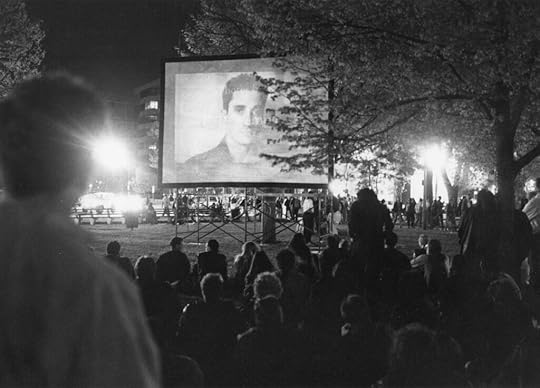 Allen Frame, Documentation of Electric Blanket: AIDS Projection Project, Dupont Circle, Washington, D.C. Eddie Marookian by Robert Williams on screen, 1993
Allen Frame, Documentation of Electric Blanket: AIDS Projection Project, Dupont Circle, Washington, D.C. Eddie Marookian by Robert Williams on screen, 1993Courtesy the artist
Manders: Can you give us a contemporary example of that formula in action?
Goldberg: Here’s one that was really moving: this student, Avery Camp, is in a class I’m teaching at the New School, and we went to the archives at the LGBT Community Center in New York to look at periodicals. Their assignment was to make a newsletter, message, poster, or sign. Avery made a flyer with information about how to volunteer for the Trevor Project, which is currently dealing with a high volume of calls and a lack of volunteers.
I asked the museum to distribute Camp’s flyer at the exhibition. J. Soto, director of engagement and inclusion at Leslie-Lohman, printed it in a handbill size for visitors to take and spread the word. That’s the legacy right there. You don’t need a lot of people to get something done. It’s not that complicated. Let’s do something now.
Images on which to build, 1970s–1990s is on view at the Leslie-Lohman Museum of Art, New York, through July 30, 2023.
April 21, 2023
A Literary Publisher’s Bold and Original Photographic Covers
This piece originally appeared in Aperture, issue 217, “Lit,” winter 2014.
New Directions, one of the most significant publishers of modernist literature, was founded on a failure. In 1933, James Laughlin, a twenty-year-old Harvard freshman and aspiring poet, traveled to Italy to study with Ezra Pound at his so-called “Ezuversity.” After assessing the younger man’s work, Pound deemed him hopeless and suggested Laughlin “do something useful. . . . Go back [to school] and be a publisher.” Three years later Laughlin took his advice, which surely would have demoralized most young writers, founding New Directions in his college dorm room. Using a hundred-thousand-dollar familial gift—Laughlin was a Pittsburgh steel heir—his first publication was titled New Directions in Prose and Poetry. An anthology, it featured William Carlos Williams, Elizabeth Bishop, Marianne Moore, e.e. cummings, Henry Miller, and Pound himself.
 Cover of Carl Rakosi, Amulet, 1967
Cover of Carl Rakosi, Amulet, 1967 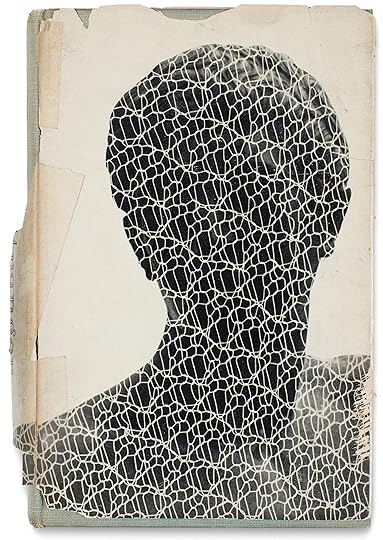 Cover of Julien Gracq, A Dark Stranger, 1950
Cover of Julien Gracq, A Dark Stranger, 1950 Laughlin would go on to publish a coterie of twentieth-century writers, including T.S. Eliot, Djuna Barnes, Tennessee Williams, Edith Sitwell, Nathanael West, John Hawkes, Kenneth Rexroth, Octavio Paz, Robert Duncan, Gary Snyder, Gregory Corso, Lawrence Ferlinghetti, Gertrude Stein, and Robert Creeley. Unlike some other American presses, Laughlin was interested in publishing foreign writers, and New Directions reprinted Herman Hesse, Rainer Maria Rilke, Franz Kafka, and Guillaume Apollinaire; Laughlin was Nabokov’s first American publisher. This whole article could be about those books and how they came to shape an essential cultural ethos. Instead it is about their significant, if less examined, covers and how they came to do the same. Ironically, given how influential the New Directions look came to be, Laughlin morally objected to the idea of people “buying books by eye.” In the preface to a 1947 collection of New Directions book jackets, he wrote, “It’s a very bad thing. People should buy books for their literary merit. But since I have never published a book which I didn’t consider a serious literary work—and never intend to—I have had no bad conscience about using [designers] to increase sales.”
New Directions covers are easy to spot but difficult to describe. They are black-and-white. They are stark, contemplative, inky, and dreamlike. They often feature cropped images—usually taken by the designers themselves and rarely credited—printed full bleed, appearing to strain against the margins that hold them. From the 1940s through the mid-1960s, the covers were designed by a small handful of art directors and freelancers, most notably Gilda Hannah, David Ford, Rudolph de Harak, and Gertrude Huston (Laughlin’s wife). In some cases, they are simple and straightforward, illustrating the title (Stand Still Like a Hummingbird by Henry Miller, which features . . . a hummingbird arrested in flight), or picturing the author (Selected Cantos by Ezra Pound).
These early photographic covers are arrestingly original—and influential in their use of photography as integral to the cover design.
In other cases, they flirt with abstraction: double exposures (Nausea by Jean-Paul Sartre), extreme close-ups (Confessions of a Mask by Yukio Mishima), long exposures (A Season in Hell by Arthur Rimbaud), negative images (Unfair Arguments with Existence by Lawrence Ferlinghetti), reticulated negatives (Confessions of Zeno by Italo Svevo), blur (The Lime Twig by John Hawkes), photogram and photo-collage (A Dark Stranger by Julien Gracq), and heavily contrasted images (The Happy Birthday of Death by Gregory Corso) proliferate within their ranks. In rare cases, the covers feature pure photographic abstraction (New Poems by Eugenio Montale). Titles and author names are at times marginalized, pushed to the edges of the frame or otherwise worked into the composition of the image. These early photographic covers are arrestingly original—before this point in publishing, book covers tended to feature billboardesque typography on a plain background—and influential in their experimentation with the plasticity of the printed image and use of photography as integral to the cover design.
 Cover of Yukio Mishima, Confessions of a Mask, 1968
Cover of Yukio Mishima, Confessions of a Mask, 1968 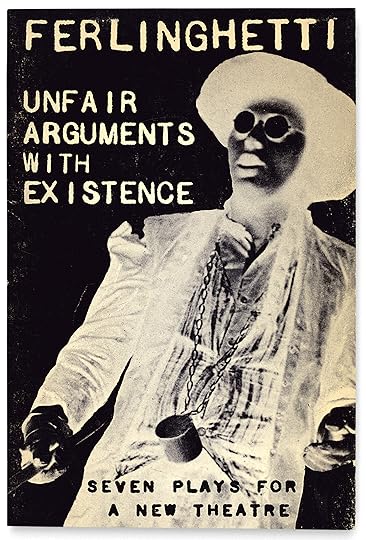 Cover of Lawrence Ferlinghetti, Unfair Arguments with Existence, 1963
Cover of Lawrence Ferlinghetti, Unfair Arguments with Existence, 1963 Perhaps due to Laughlin’s lack of interest in visual appeal, New Directions never had an institutionalized creative mandate. Instead, its earliest book covers reflect the vision that emerged from one man’s sensibility, Alvin Lustig. Laughlin met Lustig in 1940 while visiting Tennessee Williams in Los Angeles. At the time of their meeting, the young designer was working as a freelance printer and typographer, doing jobs on a letterpress that he kept in the back room of a drugstore. (Their mutual friend, the noted writer, intellectual, and bookseller Jacob Zeitlin introduced the men.) Less than a year later, Lustig designed his first New Directions cover. In an interview for this article, Lustig’s widow, Elaine Lustig Cohen—who also worked at New Directions and photographed for, designed, and collaborated on a handful of covers herself—explained that her husband had full creative reign. “There was no such thing as an art director,” said Lustig Cohen. “James did it all. Every time there was a new book, he told Alvin to do the jacket. James either liked the result or he didn’t.” This lack of interference was in keeping with Laughlin’s treatment of manuscripts, which were barely edited before being sent off to print; perhaps Laughlin’s response to Pound reflected a tendency to trust other people’s instincts with his life project.
Lustig is not especially known for his photographic covers—he worked with largely abstract collage strategies that referenced, and sometimes used, type metal from a print shop—but he did set the tone for New Directions (and indeed, the book design industry) by moving away from purely text-based covers and utilizing pared-down, graphic images that referenced the printing process. When he died at the age of forty in 1955, Gilda Hannah (then Kuhlman) succeeded him as the in-house designer. During her tenure, New Directions covers became almost entirely photographic. It was an all-in-one, streamlined job: Hannah took the majority of the photographs, occasionally commissioning an image or buying from stock, made the design and type decisions, and chose the book’s paper. She produced the cover image for The Selected Poems of Federico García Lorca using “a defective Leica” in order to achieve lens flare, went uptown in Manhattan to photograph a “relatively non-responsive” Jorge Luis Borges in his hotel room for an early edition of Labyrinths, and collaged her photograph of the Statue of Liberty for Kafka’s vertiginous Amerika cover. By the time she parted ways with the publisher in the early 1960s, citing Laughlin’s notorious lack of prompt payment, New Directions had established a recognizable and effective formula for its covers, begun by Lustig and propagated by Hannah and a small handful of freelancers (including the early Pop artist Ray Johnson): a graphic black-and-white photograph matched with modest text.
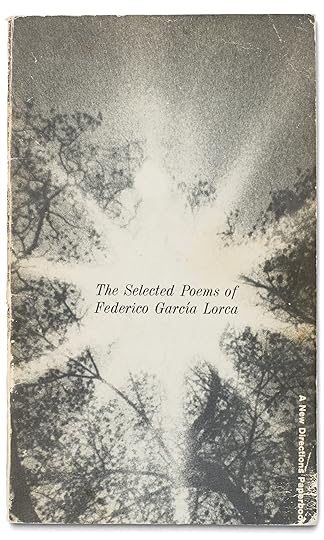 Cover of Federico García Lorca, The Selected Poems of Federico García Lorca, 1968
Cover of Federico García Lorca, The Selected Poems of Federico García Lorca, 1968 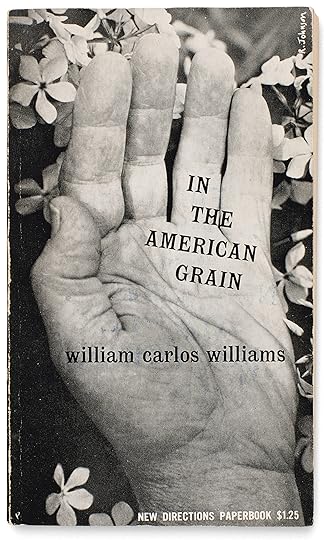 Cover of William Carlos Williams, In The American Grain, 1956
Cover of William Carlos Williams, In The American Grain, 1956All photographs courtesy New Directions Press, New York
In addition to New Directions, there were other pioneering, modernist publishers during and after this era. Knopf, and their imprint Pantheon Books, published significant fiction and poetry, including Ezra Pound; Grove Press published Samuel Beckett, Harold Pinter, and the majority of the Beat writers (including Henry Miller’s Tropic of Cancer, which New Directions had turned down for being too sexually explicit). Meridian Books printed writers like Grace Paley, Thomas Pynchon, and Ralph Ellison before going out of business. Independents such as the Jargon Society, Capra Press, Black Sparrow Books, Graywolf Press, and North Print Press, founded between 1951 and ’74, each modeled themselves in some way on New Directions. While these other publishers also tried out new design strategies—Grove Press was particularly innovative—they did so inconsistently, shifting back and forth between black-and-white and color, abstract design, photographic images, and text-only covers. New Directions managed to experiment with design without losing uniformity; they articulated a recognizable visual treatise that also boosted sales. As avant-garde poet Eliot Weinberger wrote in his 1997 obituary for Laughlin in Jacket magazine, “In my adolescence, the black-and-white photographic covers of ND books were unmistakable on the bookstore shelves, and I would buy any of them at random, knowing that if ND had published it, it was something that had to be read.” This holds true decades later for any reader of modernist literature; an early- to midcentury New Directions book is instantly identifiable on a crowded shelf.
Related Items

Aperture 217
Shop Now[image error]
Aperture Conversations
Shop Now[image error]Today, Laughlin’s theory that a cover is just an advertisement for its book, the “serious” content, would be considered diminishing and unimaginative. Covers matter beyond the stores where books are purchased or passed over; readers return to them hundreds of times over as they tunnel through a book. Cover design (especially involving photographic images) has become inexorably entangled with the experience of encountering, and traveling through, literature.
These several decades of New Directions’ photographic book covers, often the most original when they were simplest, did something truly modern: by using pictures to describe words rather than the other way around, they jettisoned the artificial boundaries between the two. They remind us that both text and image require a kind of literacy; we often speak of “reading images,” for instance, and poets challenge us to “see” words on the page. Both text and images have the potential to objectify and document our lives in a different way from, say, painting or sculpture (which are rarely utilized in a “nonartistic” sense). Denise Levertov, who published more than thirty books of poetry with New Directions, put it best in her early-1970s essay “Looking at Photographs,” written in response to a request from this magazine: “I have come to see that the art of photography shares with poetry a factor more fundamental: it makes its images by means anybody and everybody uses for the most banal purposes, just as poetry makes its structures, its indivisibility of music and meaning, out of the same language for utilitarian purposes, for idle chatter, for uninspired lying … photographs teach the poet to see better.” Levertov could have illustrated her essay with the cover of The Cosmological Eye, the first book of Henry Miller’s published in the United States—by New Directions—in 1939. Superimposed atop a full-bleed, black-and-white photograph of clouds is a single, open eye. It belongs to James Laughlin.
Hervé Guibert’s Passionately Restrained Photographs
This piece originally appeared in Aperture, issue 217, “Lit,” winter 2014.
I shall always refuse to be a photographer: this attraction frightens me, it seems to me that it can quickly turn to madness, because everything is photographable, everything is interesting to photograph, and out of one day of one’s life one could cut out thousands of instants, thousands of little surfaces, and if one begins why stop? — Hervé Guibert, The Mausoleum of Lovers, Journals 1976–1991
When Hervé Guibert died in 1991, he had just turned thirty-six. A year before, the writer, journalist, and photographer had opened his autobiographical novel, To the Friend Who Did Not Save My Life, with the declaration that he had AIDS, but went on to insist that he “would become, by an extraordinary stroke of luck, one of the first people on earth to survive this deadly malady.” When the book caused a sensation (magnified by the fact that one of its characters was a thinly disguised Michel Foucault, whose HIV-positive status contributed to his death in 1984), Guibert became the strikingly handsome, articulate, and very public face of AIDS in France. He didn’t avoid the spotlight, but it made him famous in a way he never wanted to be, and the attention exhausted him even before the disease left him frail and nearly blind. that extraordinary stroke of luck eluded him. Two weeks before he succumbed, he tried to commit suicide with an overdose of pills but failed.
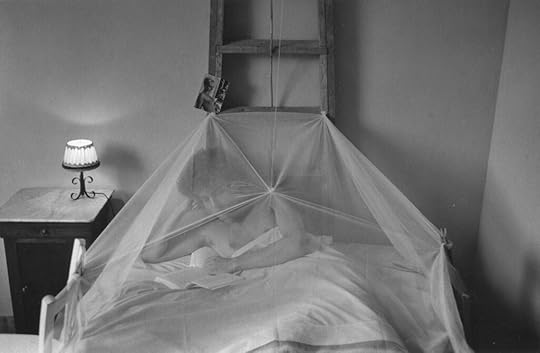 Hervé Guibert, Autoportrait (Self-portrait), 1976
Hervé Guibert, Autoportrait (Self-portrait), 1976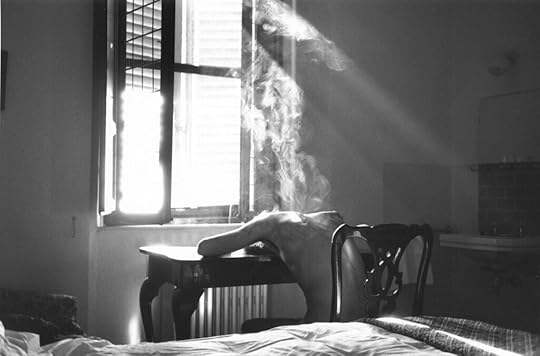 Hervé Guibert, Sienne (Siena), 1979
Hervé Guibert, Sienne (Siena), 1979Wildly prolific, Guibert was driven, compulsive, and rarely satisfied. He wrote twenty-three other books, nearly all of them in the ten years before his death (only a handful have been translated into English). In The Mausoleum of Lovers, a collection of journal entries published posthumously in 2011 and just translated, he often sounds melancholic, if not desperate, but then much of it was written as an open letter to an inconstant lover who was allowed to read the journals as they were written. Melodramatic moments—furious, passionate, delusional—alternate with cooler observations, often about photography, which was, along with writing, a highly personal form of expression for Guibert. “The photo that someone other than I could take, that isn’t bound to the particular relation I have to this or that, I don’t want to take it,” he writes.
Very little of his photographic work has been published or exhibited in the United States, so the larger body of work remains rather elusive. Still, much of what has appeared is striking: emotionally warm, even a bit sentimental at times, but stylistically cool and confident. His images range from artful interiors and landscapes to pictures of friends, family, and lovers. The mood is usually hushed and intimate. Working in a distinctive black and white that tends toward soft platinum grays, he made what feel like visual diary entries, quick but thoughtful notes, often recording his immediate surroundings—his desk, his mantel, his bookcase—with the same descriptive intensity he brought to photographs of boys in his bed. Even in his most seductive self-portraits, Guibert never seems show-offy. The work is restrained and subtle—as if it were made not with a public in mind but for himself and a small circle of friends. We often feel we’re peeking into a private and somewhat privileged world, where much is revealed and just as much withheld.
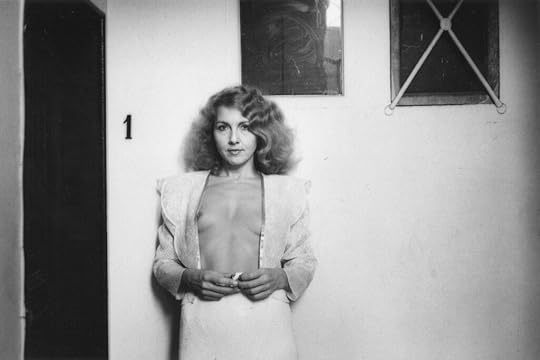 Hervé Guibert, Agathe, 1980
Hervé Guibert, Agathe, 1980 Hervé Guibert, Isabelle, 1980
Hervé Guibert, Isabelle, 1980In Ghost Image, a 1982 collection of Guibert’s brief essays on photography, reissued this year by University of Chicago Press, he writes about photographers he admires. They’re an idiosyncratic pantheon that includes Diane Arbus, Pierre Molinier, F. Holland Day, George Hoyningen-Huene, and Duane Michals, the last of whom seems especially influential on the selection of images included here. Clearly, he looked long and hard at his precursors and his contemporaries, but some of his most telling essays are dialogues with his critical self, an accusatory voice that he never allows to have the last word. When that voice points out that much of his work “oozes homosexuality,” he shoots back:
“How could it be otherwise? It’s not that I want to hide it, or that I want to boast about it arrogantly. But it’s the least I can do to be sincere. How can you speak about photography without speaking of desire? If I mask my desire, if I deprive it of its gender, if I leave it vague . . . I would feel as if I were weakening my stories, or writing carelessly . . . The image is the essence of desire and if you desexualize the image, you reduce it to theory.”
Guibert’s criticism can stray into knotty intellectual territory, but he steers clear of dry, deadening theory. What’s most engaging about his work in writing and photography is its frankness and sincerity—qualities the contemporary avant-garde has little use for. Even his restraint feels passionate—an elegance at once instinctive and hard-won.
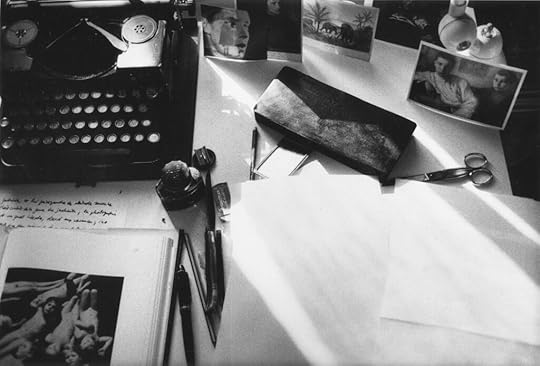 Hervé Guibert, Table de travail (Work table), 1985
Hervé Guibert, Table de travail (Work table), 1985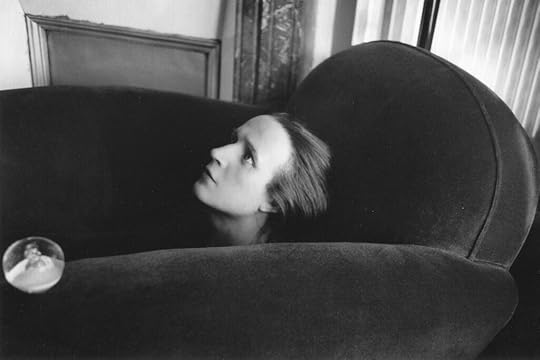 Hervé Guibert, La tête de Jeanne d’Arc (The head of Joan of Arc), n.d.
Hervé Guibert, La tête de Jeanne d’Arc (The head of Joan of Arc), n.d. All photographs courtesy Callicoon Fine Arts, New York
Related Items

Aperture 217
Shop Now[image error]
Aperture Magazine Subscription
Shop Now[image error]Why Are We Seeing So Many Photographs on Book Covers?
This piece originally appeared in Aperture, issue 238, “House & Home,” spring 2020.
The British writer Rachel Cusk’s celebrated Outline trilogy, published between 2014 and 2018, concerns a series of journeys a writer named Faye takes in Europe. In one, Faye encounters a woman who is obsessed with the works of a painter. “What she was trying to say was that she wasn’t interested in them objectively, as art,” Cusk writes. “They were more like thoughts, thoughts in someone else’s head that she could see.”
A recent spate of well-regarded novels has taken the use of photographs in book jacket design into new territory, structuring a relationship between word and image. The U.K. Faber and the U.S. Picador editions of Cusk’s trilogy, designed by Rodrigo Corral, make use of still lifes by the fashion photographer Charlie Engman. The thick white border and the bold black all-caps text frame an image that offers a way into thinking about what the individual titles of the trilogy might refer to—Outline, Transit, Kudos. But after reading the book, you realize how provisional the cover’s illustrative nature is. Corral’s design was in reaction to reading Cusk’s prose: “It isn’t super linear,” he says. “It’s more about being part of the journey.”
 Rachel Cusk, Transit (2018), with photograph by Charlie Engman
Rachel Cusk, Transit (2018), with photograph by Charlie EngmanThe U.S. edition of the American writer and T Magazine editor Hanya Yanagihara’s novel A Little Life (2015) and the U.K. edition of the British writer Olivia Laing’s first novel, Crudo (2018), turn this observation concrete. Both novelists were inspired to use photographs for their book jackets after seeing them in galleries. Yanagihara saw Peter Hujar’s Orgasmic Man (1969); Laing saw Wolfgang Tillmans’s astro crusto (2012). Laing has noted that Tillmans’s image of a postprandial crustacean shell connects to a scene in the book where her lead character, Kathy, smashes a crab open with a hammer.
But the principle of using someone else’s work to frame your own rises above the evident linkage. Laing’s use of the American writer Kathy Acker as her protagonist—partly quoting Acker’s work, largely fictionalizing her life—is a feature of her style of autofiction, but it is also bound up with how writing is described in the novel: “She wrote fiction, sure, but she populated it with the already extant, the pre-packaged and ready-made.” Laing’s Kathy is described as “Warhol’s daughter,” someone who is “happy to snatch what she needed but also morally invested in the cause.”
It’s a description that is as much about image use in publishing as it is about writing. The cover of A Little Life reproduces Hujar’s photograph of a close-up of a man’s face at the point of orgasm; although shorn of its title, the ambivalence about whether it’s a face in agony or ecstasy is ramped up. Yanagihara has described the cover as a “sensation—of witness and also of trespass—that I wanted the reader to feel as well.” A Little Life opens in New York in the early 1980s, a time when Hujar was still working, and chronicles the lives of four young men with a tight focus on private and inner worlds as represented by the cover. One of the four, JB, is an artist, and the photographs he takes of his friends—depicting them in his artworks without their consent—is what begins his distance from them. “Tonight, I am a camera, he told himself, and tomorrow I will be JB again.”
Related Items
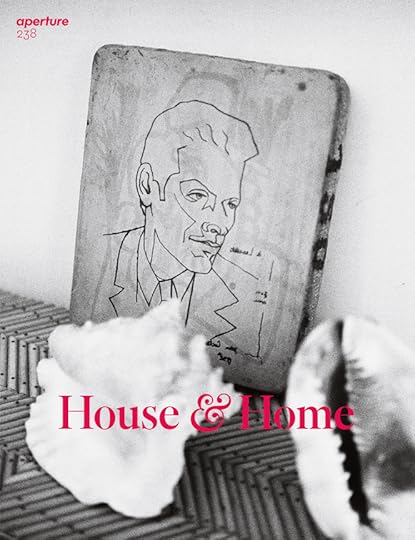
Aperture 238
Shop Now[image error]
Aperture Magazine Subscription
Shop Now[image error]The novel’s Instagram account, set up by Yanagihara and her social-media manager, has spawned similar reactions in readers—not through posting portraits of their friends as the book’s character does, but by posting portraits of themselves with the book itself. As one London-based reader’s body extends out from the jacket, it’s as if a novel can be slipped on and off like an alternate, temporary identity or a thing worn. It’s a performance that resonates with something the feminist art historian Linda Nochlin wrote: “That the self is a condition of disguise and that we can move back and forth in terms of sexualities, in terms of social being, in terms of all kinds of sense of who we are.”
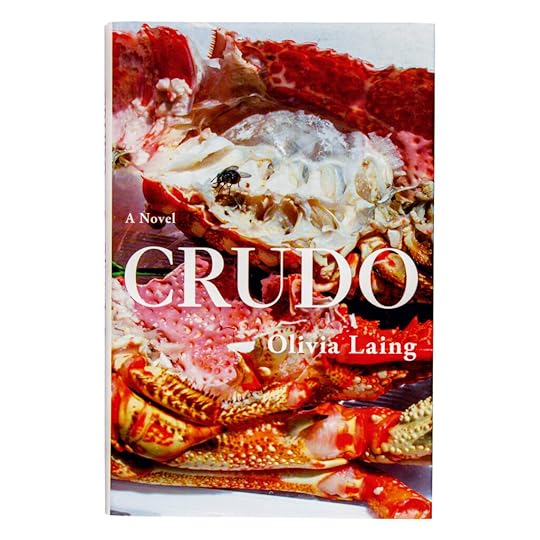 Cover of Olivia Laing, Crudo (2018), with photograph by Wolfgang Tillmans
Cover of Olivia Laing, Crudo (2018), with photograph by Wolfgang TillmansWhat these book jackets illuminate is the way the contemporary novel, both in content and cover, performs the idea of the self continually collapsing back onto other ideas, other images—as if somehow the prose operates as a written means of interconnectedness between visual ideas, a kind of long-form resort to the pictorial. It’s a queer way of defining things, a privileging of final looks over how things might first be written down. It seems somehow reminiscent of record covers and not book jackets, of the photographs Steven Patrick Morrissey once chose for the singles and albums The Smiths released, or of the covers Peter Saville once designed for Joy Division and New Order that made use of sourced photographs. Perhaps it is the realization that novels are now the sleeve notes of our time.
April 18, 2023
Announcing the 2023 Aperture Portfolio Prize Shortlist
Aperture’s support of emerging photographers and other lens-based artists is a vital part of our mission. The annual Aperture Portfolio Prize aims to discover, exhibit, and publish new talents in photography—identifying contemporary trends in the field and highlighting artists whose work deserves greater recognition.
Aperture’s editors reviewed over one thousand submissions, and we are thrilled to announce the shortlisted artists for the 2023 Aperture Portfolio Prize:
Samantha Box
Brian Lau
Akshay Mahajan
Vân-Nhi Nguyễn
Ziyu Wang
These artists join the ranks of illustrious winners and artists shortlisted for the Portfolio Prize in past years, including Felipe Romero Beltrán, Dannielle Bowman, Alejandro Cartagena, Jessica Chou, Eli Durst, LaToya Ruby Frazier, Natalie Krick, Daniel Jack Lyons, Mark McKnight, Drew Nikonowicz, Sarah Palmer, RaMell Ross, Bryan Schutmaat, Donavon Smallwood, Ka-Man Tse, and Guanyu Xu.
The 2023 Portfolio Prize winner, to be announced on Friday, May 12, will be published in Aperture magazine, receive a $3,000 cash prize and a $1,000 gift card to shop for gear at mpb.com, and present an exhibition at Baxter St at the Camera Club of New York. Each runner-up will receive an online feature.
Alongside the five shortlisted artists, twenty finalists were selected by Aperture’s editors. The finalists and shortlisted artists will each receive a virtual portfolio review session with an Aperture editor, who will provide thoughtful and constructive feedback on their work.
The twenty finalists are:
Hannah Altman, Sasha Arutyunova, Kerr Cirilo, Rose Marie Cromwell, Santiago Escobar-Jaramillo, Natalie Ivis, Hassan Kurbanbaev, Camille Farrah Lenain, Drew Leventhal, Morgan Levy, Jesse Ly, Kavi Pujara, Guarionex Rodriguez, Hyunmin Ryu, Agnieszka Sosnowska, Mika Sperling, Kai Wasikowski, Jaclyn Wright, Leafy Yeh, Rana Young
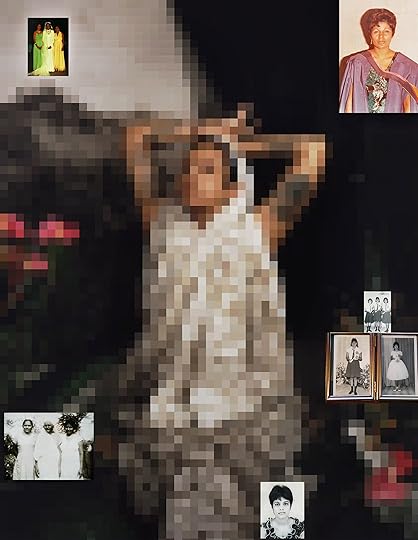 Samantha Box, One Kind of Story, 2020, from the series Caribbean Dreams
Samantha Box, One Kind of Story, 2020, from the series Caribbean Dreams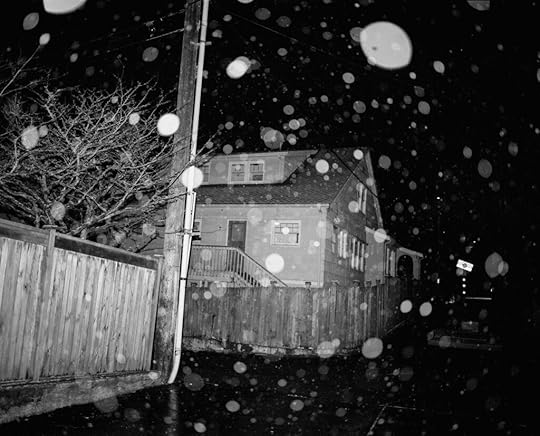 Brian Lau, House in Flurry, 2020, from the series We’re Just Here For the Bad Guys
Brian Lau, House in Flurry, 2020, from the series We’re Just Here For the Bad Guys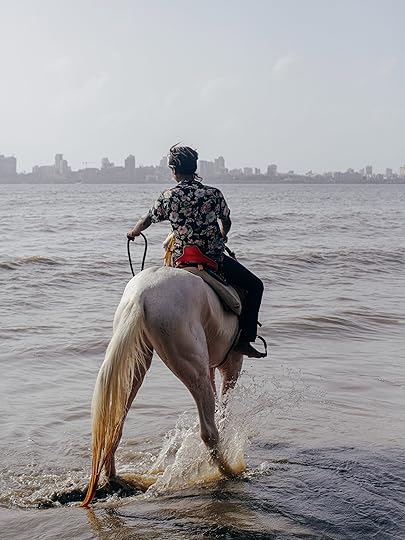 Akshay Mahajan, from the series To die is to turn in gold
Akshay Mahajan, from the series To die is to turn in gold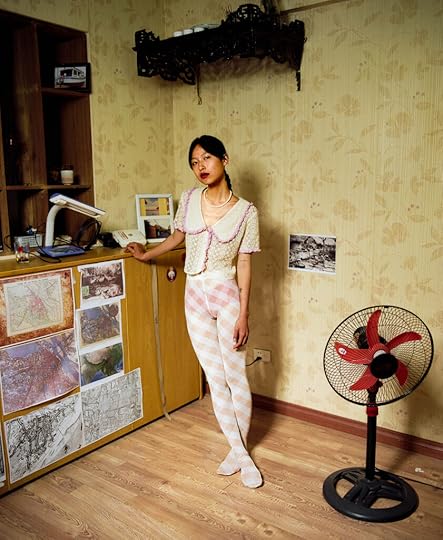 Vân-Nhi Nguyễn, Untitled (Girl with Pearls), 2022, from the series As You Grow Older
Vân-Nhi Nguyễn, Untitled (Girl with Pearls), 2022, from the series As You Grow Older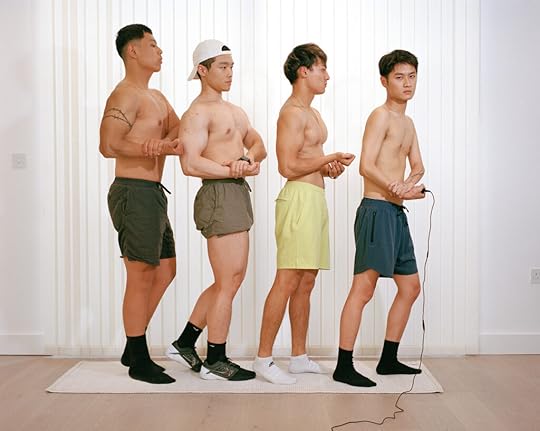 Ziyu Wang, Lads, 2022, from the series Go Get ‘Em Boy
Ziyu Wang, Lads, 2022, from the series Go Get ‘Em Boy
April 14, 2023
The Delight and Absurdity of Domestic Photography
Throughout the pandemic, the popular conception of home became a place of unrelenting monotony—a site of confinement, despair, potentially even breakdown. Creativity was stifled when stuck in one’s living room. It was impossible to maintain professional output while sharing a space with one’s children. To many women, this new obsession with the inside, the domestic, was both frustrating and amusing. Home was now a space confining both sexes. And yet, female artists have long centered home as a site for probing discussions and creative explorations. The resultant works often deal with the themes that contributed to women’s very presence at home in the first place: sexism, pay disparity, childcare inequality, patriarchal conditioning and control.
The domestic and, in turn, the family have been popular topics within the history of photography, as well as the subject of various notable exhibitions—for example, Pleasures and Terrors of Domestic Comfort at the Museum of Modern Art, in New York, in 1991, and Who’s Looking at the Family? at London’s Barbican, in 1994. Many of these were curated, in part, to redress the lack of female representation within museum shows, a fact that makes the included works’ commentary on the narrowness of women’s opportunities and freedoms only more poignant. Women photographers were in the museum, and yet, somehow, still at home, in their place.
 Spreads from Talia Chetrit, Joke (MACK, 2022)
Spreads from Talia Chetrit, Joke (MACK, 2022) 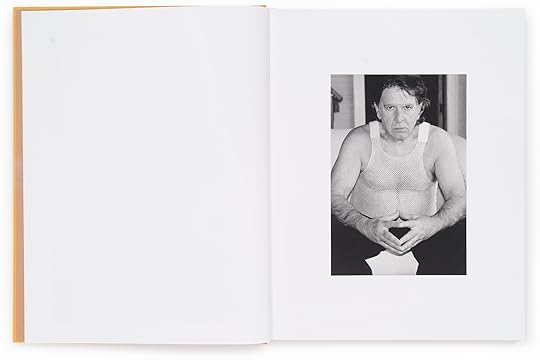
In the catalog for Pleasures and Terrors, which featured Ellen Brooks, Jo Ann Callis, Doug DuBois, William Eggleston, Cindy Sherman, Sage Sohier, and Carrie Mae Weems, among others, the curator, Peter Galassi, wrote that artists “began to photograph at home not because it was important, in the sense that political issues are important, but because it was there—the one place that is easier to get to than the street.” The comment likely amused some female artists at the time but now reads as starkly unperceptive, if not blind to varied motivations in creative experience. This lack is especially obvious when one surveys just a few of the many new books and photographic projects dealing with home and domesticity: Talia Chetrit’s Joke (MACK, 2022), Csilla Klenyánszki’s Pillars of Home (Self-published, 2019), and Kuba Ryniewicz’s Daily Weeding (Note Note Éditions, 2021).
These image makers photograph home both because it is “there” (and was “there” more obviously than ever during the pandemic) and because it is “political” and “important,” to use Galassi’s aspirational words. Both Chetrit and Klenyánszki infer that the very fact of their both, as women artists and mothers, being “there” (at home, caring for babies) is, in itself, fruitful territory for the exploration of some of the most troublesome and limiting divisions, and habits of thinking, within society. Who is a mother? What behaviors make her good? What subjugations should she tolerate? What should she keep of herself? Can she be sexual? Can she be an artist? Who is a father figure? Is he at home too? What is home? In Chetrit’s pictures especially, the send-up of familial tropes and domestic scenes, with humor and light irony, is enjoyable—an older man sits, legs spread, his chest hair showing through his mesh undershirt; a young father, wearing a dress with layers of yellow tulle, stands next to his baby; disembodied mannequin limbs appear on the page before a close-up of a caesarean scar.
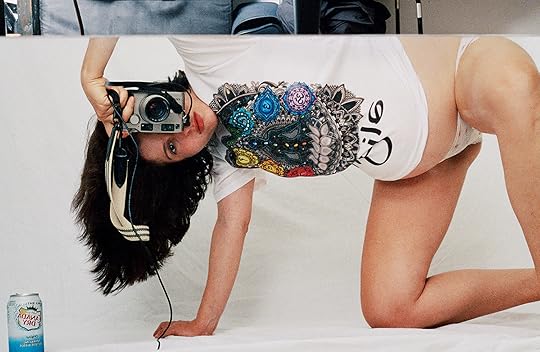 Talia Chetrit, Align, 2019, from Joke (MACK, 2022)
Talia Chetrit, Align, 2019, from Joke (MACK, 2022)  Talia Chetrit, Model Family, 2020–22, from Joke (MACK, 2022)
Talia Chetrit, Model Family, 2020–22, from Joke (MACK, 2022) The works made me think of Jo Spence and Patricia Holland’s book, Family Snaps: The Meanings of Domestic Photography (1991), in which Spence asks, “The family album: what does it contain? What lies beyond the symbolic images of special events, occasions, celebrations, ‘success’—particular weddings, the new baby, holidays, the ‘happy family’?” Spence offers, “Perhaps, superficially, family albums tell us more about the accepted ways of picture-making, or what was considered appropriate at any historical time, than they do about the particular family represented?” Chetrit’s goal seems to be to revile “appropriateness,” to thumb a nose at the serenity and wholesomeness that are expected in depictions of mothers, families, and children.
 Aperture Magazine Subscription Get a full year of Aperture—and save 25% off the cover price. Your subscription will begin with the winter 2022 issue, “Reference”.
[image error]
[image error]
Aperture Magazine Subscription Get a full year of Aperture—and save 25% off the cover price. Your subscription will begin with the winter 2022 issue, “Reference”.
[image error]
[image error] 
In stock
Aperture Magazine Subscription $ 0.00 –1+ View cart DescriptionSubscribe now and get the collectible print edition and the digital edition four times a year, plus unlimited access to Aperture’s online archive.
On the first page, we see a baby, naked except for a diaper, playing in front of a shelf of children’s books (Madeline and the Cats of Rome, Mr. Tiger Goes Wild). In front of it, a single adult leg bisects the image, masking half the child: the leg wears a shiny black thigh-high boot. The combination of the supposedly pure and the latently erotic is designed to disarm, to nod to the many often irreconcilable fetishes that surround women—mother, sex object, Madonna, whore. Chetrit’s picture is also funny, as a visual. I laughed when I saw it. Projects about home often deal with pungent dichotomies: prosperity versus compromise, safety versus violence. Chetrit composes such juxtapositions with refreshing lightness, refusing to be solemn, sentimental. The book’s title here—Joke—is perfect. She finds the traditional stereotypes of family ridiculous. She will not dignify them with anger. Her humor is always more sardonic than slapstick, a little knowing, a little cool. The inclusion of high fashion in the images (Balenciaga jeans, a micro Chanel handbag) is unsurprising—Chetrit has photographed for various brands, such as Acne Studios and Celine—but contributes to the sense of insolence and chilliness. Such inclusions give the work an impenetrability, which in itself refutes the idealized vision of mothers as open, kind, soft, welcoming.
 Spread from Csilla Klenyánszki, Pillars of Home (Self-published, 2019)
Spread from Csilla Klenyánszki, Pillars of Home (Self-published, 2019)There is also wit in Klenyánszki’s Pillars of Home, which makes a physical manifestation of the concept of juggling, a buzzword in so many conversations about domesticity and motherhood. The small-scale book features photographs of sculptures built from household objects during the photographer’s baby’s nap time. The statues are precarious: a baguette is about to snap under the weight of an umbrella, a pile of oranges is ready to tumble down. In Pillars of Home, Klenyánszki writes that, should the installation collapse, not only will the “existence of the image” be “in danger” but also “the noise of the fallen objects might awaken the sleeping baby, which puts an end to the working session.” The book is a comment on limited freedom—on the way a child restricts options and hampers work, the way the family can smother the individual.
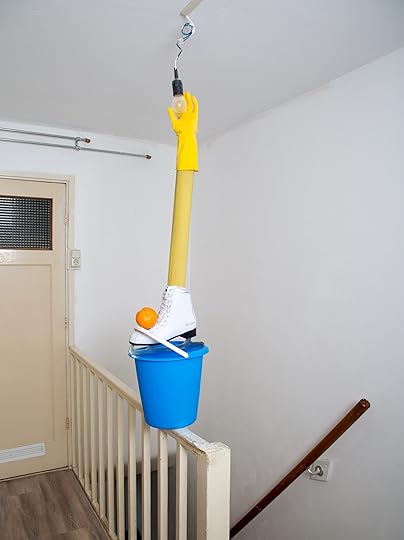 Csilla Klenyanszki, Nr18, from Pillars of Home (Self-published), 2019
Csilla Klenyanszki, Nr18, from Pillars of Home (Self-published), 2019 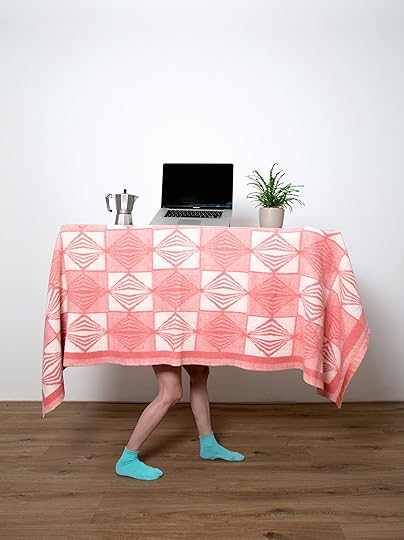 Csilla Klenyanszki, Nr74, from Pillars of Home (Self-published), 2019
Csilla Klenyanszki, Nr74, from Pillars of Home (Self-published), 2019 Looking at each sculpture, one imagines the forthcoming crash, a wail from an adjacent room, the rush of feet toward the cry as the objects shatter or roll, the vibrations spreading across the room. The best images are the ones where the fall seems certain and particularly violent: a vase of flowers balances on an open door, a pair of splayed scissors sits vertically on top of the blooms. One knows it will come down. There is a shakiness and vulnerability that seems in keeping with the precariousness of our times. Everything we build, the supposed securities of home and family, can be swept away in a moment by external factors: pandemic, death, war, climate change, the cruelty and inexplicability of other people’s choices.
These books speak of an age of juxtapositions, dissonance, oddness—of uncanniness, within the home as everywhere.
Klenyánszki’s book nods to the arguable irrationality of bringing a child into a collapsing world. One of the project’s weaknesses—repetitiveness—is also its strength. By the middle of the book, the photographs, and sculptures, start to blend; one tires. It infers the relentlessness of child-rearing, of life in a small apartment, and, in turn, the relentlessness of worry, instability, crisis.
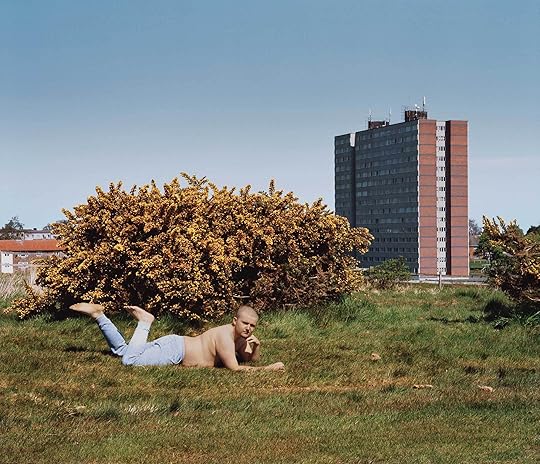 Kuba Ryniewicz, from Daily Weeding (Note Note Éditions, 2021)
Kuba Ryniewicz, from Daily Weeding (Note Note Éditions, 2021) 
The monotony of crisis also underpins Ryniewicz’s Daily Weeding, which was made during lockdown, and features images of friends and neighbors hanging out near high-rise tower blocks, gardening, or nurturing swollen pregnant stomachs. An accompanying text by Olivia Laing refers to “love in a tiny space.” She wonders, “Could it still feel free?”
Advertisement
googletag.cmd.push(function () {
googletag.display('div-gpt-ad-1343857479665-0');
});
Writing in the introduction to Family Snaps, Holland argues that “making and preserving a family snapshot is an act of faith in the future.” What all three books, but especially Joke and Pillars of Home, present is the family snapshot when that faith in the future is shaken, no longer rational or appropriate. They speak of an age of juxtapositions, dissonance, oddness—of uncanniness, within the home as everywhere. If the function of the family photograph has typically been to serve as propaganda for traditional systems, for conformity and the illusion of bliss, these works seek to unsettle, to gently mock. But they are not simplistic manifestos. All three books retain the deeply personal aspects, along with a sense of quotidian flow, that make domestic photography interesting. They are as much records of ambivalence as of anger, of acceptance punctuated by occasional flashes of thirst for self-fulfillment, authorship, and—the perpetual great threat to home and family—more.

 Kuba Ryniewicz, from Daily Weeding (Note Note Éditions, 2021)
Kuba Ryniewicz, from Daily Weeding (Note Note Éditions, 2021) This article originally appeared in Aperture, issue 250, “We Make Pictures in Order to Live,” in The PhotoBook Review.
April 7, 2023
The Struggle for Survival in the Amazon
For more than fifty years, the photographer Claudia Andujar has collaborated with, advocated for, and photographed the Yanomami, the Indigenous people who inhabit a swathe of Amazonia that stretches across Brazil and Venezuela and face dire threats to their autonomy and survival from settler farmers, illegal gold miners, and malignant right-wing political forces. The Yanomami Struggle at the Shed in New York is the latest iteration of an exhibition that features more than two hundred of Andujar’s most iconic and striking photographs of the community as well as videos and more than eighty drawings and paintings by Yanomami artists.
Since first meeting members of the Yanomami in 1971, Andujar has attempted to capture the daily life and spiritual essence of Yanomami worlds with experimental photographic techniques, using infrared film, saturated-color filters, and lens and exposure manipulations to translate their lifeways and spiritual systems for outsiders. Andujar has dedicated most of her life and career to the Yanomami cause and their communities as a singular subject. Yet despite Andujar’s sincere belief that images can help protect these people from the encroachment of coloniality, a lingering tension consumes her work. She attempts to represent both worlds foreign to her and sites of struggle through a lens that carries the baggage of ethnography’s most romanticizing and preservationist impulse—that her subjects’ value is in their being untouched by modernity.
 Claudia Andujar, Illegal gold mining barge in Yanomami territory, ca. 1989
Claudia Andujar, Illegal gold mining barge in Yanomami territory, ca. 1989 © the artist
Unlike recent iterations of this traveling exhibition, this tension finds some relief in the Yanomami artworks that visualize not only the community’s life and cosmological worlds but also their struggle against the theft and destruction of their land by deforestation, slash-and-burn farming, and strip mining. These contributions do much to counter Andujar’s tendency toward the ethnographic, allowing for her decades-long advocacy-through-representation to operate more collaboratively with Yanomami voices.
 Claudia Andujar, Catrimani region, 1972–76
Claudia Andujar, Catrimani region, 1972–76 © the artist
 Claudia Andujar, Collective house near the Catholic mission on the Catrimani River, Roraima state, 1976
Claudia Andujar, Collective house near the Catholic mission on the Catrimani River, Roraima state, 1976The Yanomami Struggle takes up the entirety of the Shed’s main exhibition hall, which is divided into five spaces that present six thematic sections. At previous venues in São Paulo, Paris, and London, the exhibition presented Andujar’s work largely on its own. In New York, her photographs are juxtaposed with fifty-eight new drawings, paintings, and prints and three new short films by Yanomami artists. Many of these works are from the Fondation Cartier’s collection and are being shown in the US for the first time. Andujar’s photographs are suspended throughout the Shed’s main space, in a constellation of black-and-white portraits and saturated infrared images of Yanomami homes and environs: pink jungle canopies, bright orange and yellow yano (communal houses) surrounded by sweet-potato leaves, and glittering blue waterways and star-covered palm-leaf roofs. Interspersed throughout are figurative drawings in colored pencil and felt pen by Yanomami artists Joseca Mokahesi and Ehuana Yaira and shaman and leader Davi Kopenawa—who depict origin stories and xapiri (spirit helpers) with expressive intensity. The exhibition is no longer dedicated to Andujar’s work and activism, as past iterations have explicitly stated, but rather to “the long-term collaboration” of Andujar and the Yanomami people, as the exhibition’s introductory text states.
 Installation view of
The Yanomami Struggle
, The Shed, New York, 2023. Photograph by Adam Reich
Installation view of
The Yanomami Struggle
, The Shed, New York, 2023. Photograph by Adam Reich Courtesy Fondation Cartier
 Installation view of
The Yanomami Struggle
, The Shed, New York, 2023. Photograph by Adam Reich
Installation view of
The Yanomami Struggle
, The Shed, New York, 2023. Photograph by Adam Reich Courtesy Fondation Cartier
The show has accordingly become less of an anthropological photo essay or biographical retrospective and more of an aesthetic collaboration. Most notable among these collaborators are Andujar’s primary partners in efforts to defend the community, the shaman and Yanomami leader Davi Kopenawa, a central advocate and spokesperson for the Yanomami on the international stage, and the anthropologist Bruce Albert. Both also provide statements on the exhibition labels that explain Yanomami life, culture, and spiritual beliefs.
The tension between solidarity and romanticization remains throughout, however. On one wall are Andujar’s chiaroscuro portraits of Yanomami individuals, titled Moving Identities, which seem to escape the anthropological with intimate framing and dramatical shadowing from the naturally lit yano interiors in which they were taken. Yet the titles straddle portraiture (Moxi Hwaya u thëri, Vital Warasi’s son, 1974–76) and ethnographic modes of description (A young man’s foreskin is tied to his waist with cotton thread, 1974). The section immediately following the main hall, Rites and Vision, is the most fraught, with photographs focused on reahu (funerary rituals). Kopenawa’s description of associated rites, in which shamans “take our image into the time of dream,” is an evocative explanation of the power of image making in Yanomami belief.
 Davi Kopenawa, The house of the xapiri spirits, 2003
Davi Kopenawa, The house of the xapiri spirits, 2003© the artist
The Yanomami Struggle was curated by Thyago Nogueira, head of contemporary photography at the Instituto Moreira Salles in São Paulo, where it debuted, with the guidance of Kopenawa, whose voice is the prominent in the explanatory labels. We are left to trust in the collaborative process as to whether images of Yanomami people and rituals are fit for outsiders to view, and must acknowledge the agency of community collaborators. The film Earth Forest Shamans (2014), for example, directed by Yanomami filmmaker Morzaniel Iramrɨ, documents a reahu over the course of one hour, bulwarking against exoticizing impulses with an Indigenous lens.
Multiple Visions, the section of the exhibition dedicated entirely to Yanomami art, comes as a relief. It contains only several portraits of the artists by Andujar. Whereas the drawings in the opening section use figuration to depict Yanomami oral histories and spirit beings, the artists here tend toward abstraction to translate an experience of the landscape and the influence of the spiritual beings that inhabit them. Visions of the world of the xapiri by André Taniki, Vital Warasi, and Orlando Nakɨ uxima, executed in felt pen and colored pencil in the 1970s, are electric fields of vibrating lines and pictographic figures. Recent acrylic paintings and stamped monotypes by Sheroanawe Hakihiiwe depict Atayu ihiupi husipe pesi (caterpillar cocoons) and Moka maimki (frog legs) with repetitions of stunning organic geometries.
The exhibition is no longer dedicated to Andujar’s work and activism, as past iterations have explicitly stated, but rather to “the long-term collaboration” of Andujar and the Yanomami people.
There is, on the one hand, a sense of the artists as informants, in which they illustrate their cosmological worlds for inquiring colonial minds in search of ethnographic data. On the other hand, these Yanomami works are undeniably the emergent forms of an Indigenous modernist movement. The exhibition appeals to a taste for authentic and unmediated Indigenous worlds, but it is transparent about their very real mediation, either by presenting facsimiles of the earliest works on paper, in some cases, or by referring to pens and pencils as the “tools” first provided to these artist-shamans in 1974 by Andujar and Carlo Zacquini to document their worlds on their own terms. Either way, the cosmovisions of Yanomami shamanic practitioners are deployed as opportunities to translate unseen worlds for audiences seeking to be transported to “untouched” sites of wonder.
In the final room of the exhibition, focused on the sections Struggle and Fight and Vaccination and Health, Andujar’s photography transitions to more explicit and straightforward realism to reflect the worsening conditions of life in the Amazon. Even with Brazil’s election of President Luiz Inácio Lula da Silva in 2022 and the subsequent creation of the country’s first Ministry for Indigenous Peoples, the Yanomami face ongoing invasion by extractive capitalism and encroaching settler-colonial governments and extractive capitalism. The genocidal overtones of such campaigns are reflected in Marcados, Andujar’s series of numbered identification photographs that depicts the bureaucratic organization of the Yanomami during a critical vaccination program in the 1980s.
 André Taniki, Visions from the world of the xapiri, with its houses, mirrors, and paths, 1978–81
André Taniki, Visions from the world of the xapiri, with its houses, mirrors, and paths, 1978–81 © the artist
The terrible potential of such systems is not lost on Andujar, who narrowly escaped the Holocaust as a child, and the show here closes with a multimedia installation based on the 1989 exhibition Genocide of the Yanomami: Death of Brazil. The flashing portraits overlaid with the word morrer, Portuguese for “to die” but also “to fade,” are a culminating visualization of the existential threat to the Yanomami and illustrates how Andujar’s own background has contributed to her half-century-long dedication to this subject and cause. But despite the calls to action by Andujar and others that make apparent the ongoing need for solidarity, there remains the painful and unavoidable irony that the exhibition is organized by the Fondation Cartier, a philanthropic nonprofit funded by the sale of precious-metal jewelry and luxury goods.
“While you destroy, we draw,” Davi Kopenawa said through a translator at an event at Princeton University, several days before the exhibition’s opening. “We contemplate trees trembling, and we observe nature. It is important for you to respect the lungs of the Amazon, to not destroy it, to value this through art. We make art also to protect our land . . . We are drawing, and we are making the white man understand what we do while they are living in the cities.” One might wonder what The Yanomami Struggle would be without Andujar’s photographs, showing only the art, film, and voices of the Yanomami contributors. Perhaps that could be the next iteration of the exhibition, and indeed of Andujar’s activism itself, allowing for the ally and her image making to fade into the background while the Yanomami express, through drawing and political action alike, full sovereignty over their representations and lands.
The Yanomami Struggle is on view at The Shed, New York, through April 16, 2023.
Aperture's Blog
- Aperture's profile
- 21 followers



